12 + 1 Fashion Portfolio Examples & How to Build Yours
Browse through some outstanding examples and learn how to build your own striking portfolio with flying colors!
If fashion is your passion, then you are at the right place! We selected some exceptional fashion portfolio examples so you can draw inspiration and learn how to create your own portfolio.
If you have already read our article on how to build a fashion portfolio, you are probably wondering how others succeeded. Let's take a look!

Get early access to our fashion portfolio website builder and become a portfolio expert in no time!
Fashion portfolio examples
Here are the 12 most inspiring fashion portfolio examples.
1. Paolo Belleri

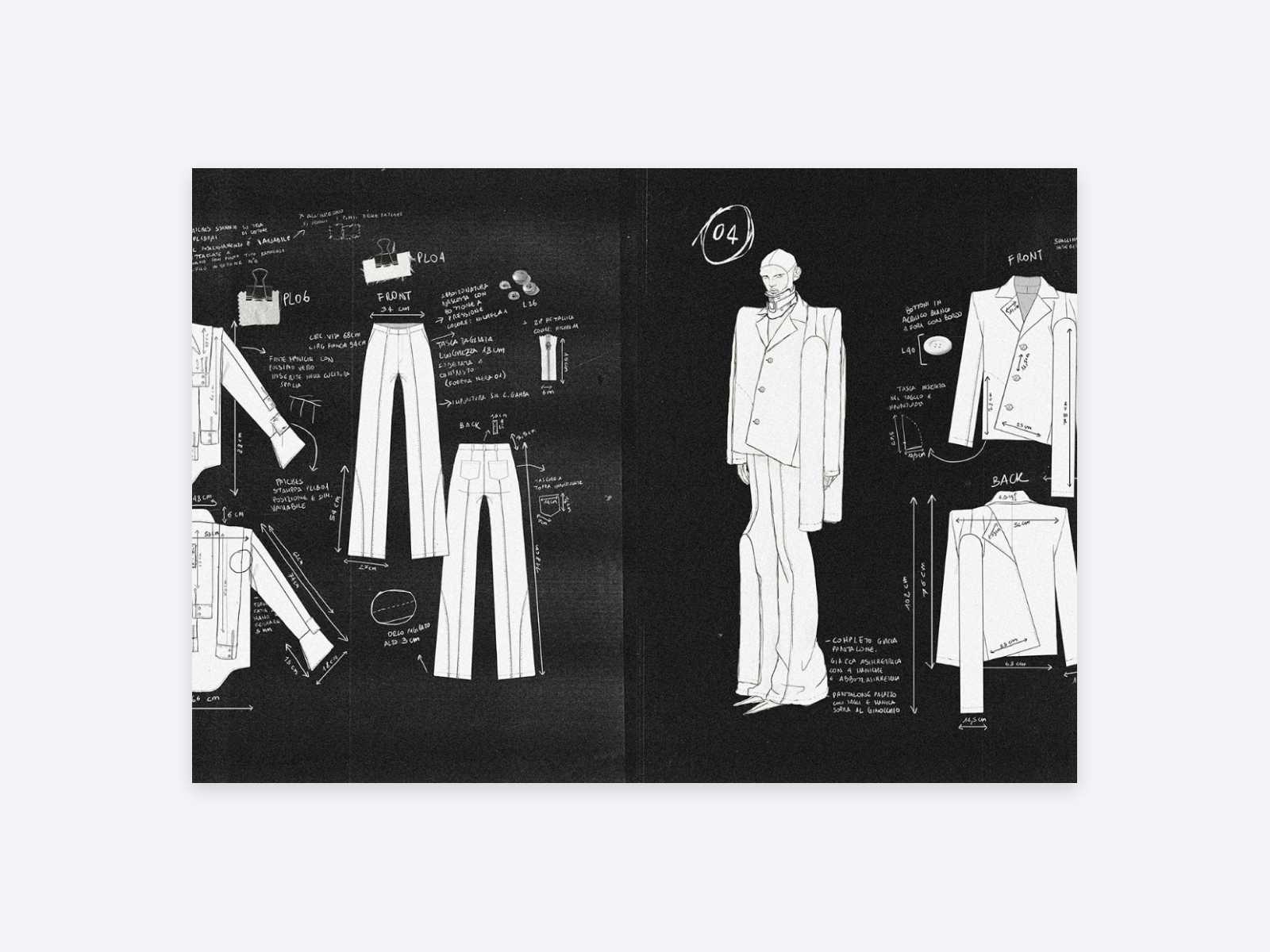
Paolo's fashion portfolio

Paolo's fashion portfolio
What can you learn from Paolo’s portfolio?
- A strong front page
Paolo’s portfolio is about daring to be different and making unusual choices. His offbeat front page and the black and white color choice bring a rock'n'roll vibe that we love. - Outstanding fashion sketches
Paolo chooses a unique approach with his fashion sketches. The pitch black background and white chalk-like sketches complement each other. Interested in illustration? Learn how to make an illustrator portfolio. - Images that are matching the design
The image selection fits perfectly with the mood of the design and the portfolio itself. You can feel the 80s and an edgy vibe coming through Paolo’s fashion portfolio.
2. Monika Misiak

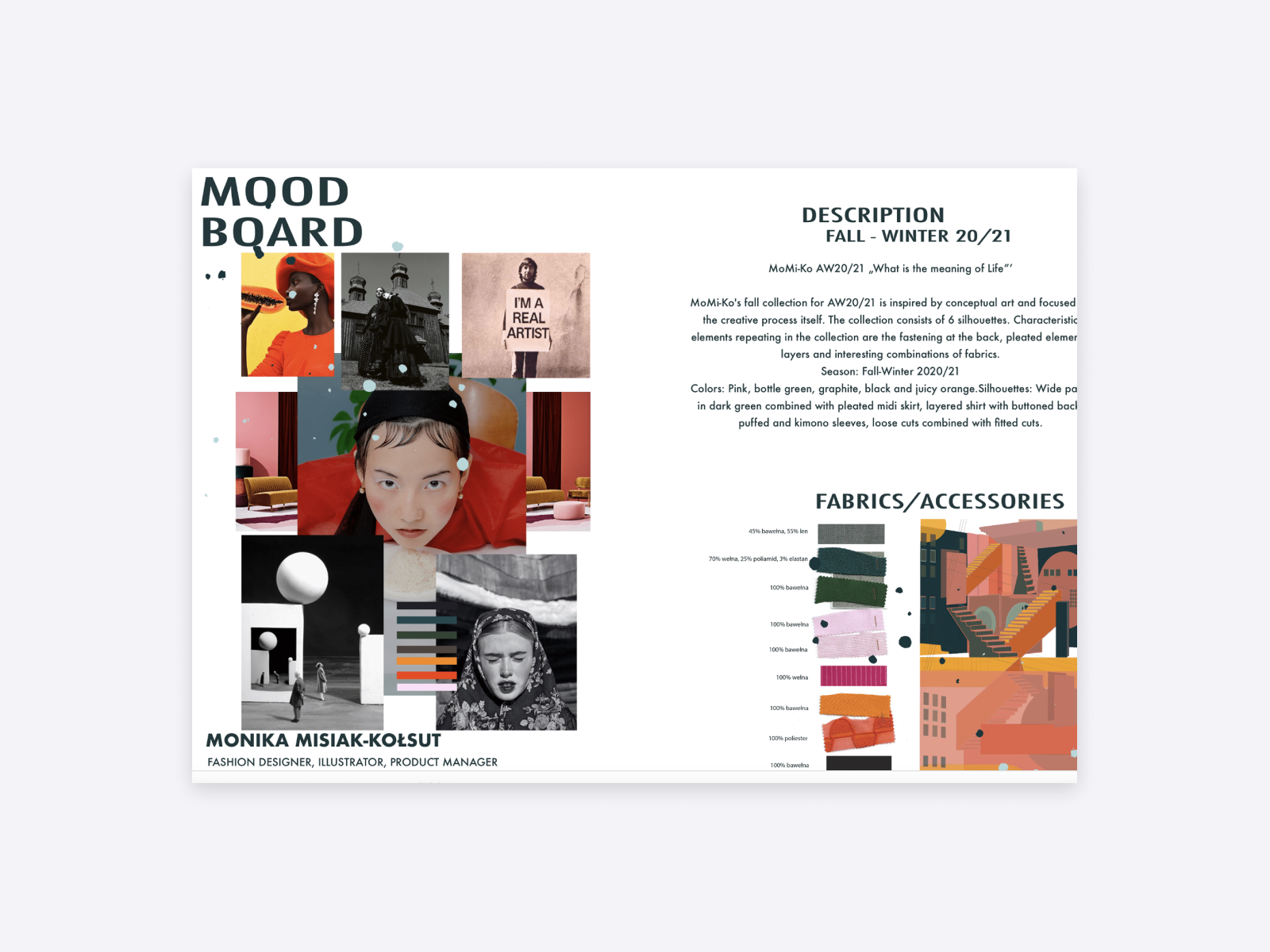
Monika Misiak's fashion portfolio
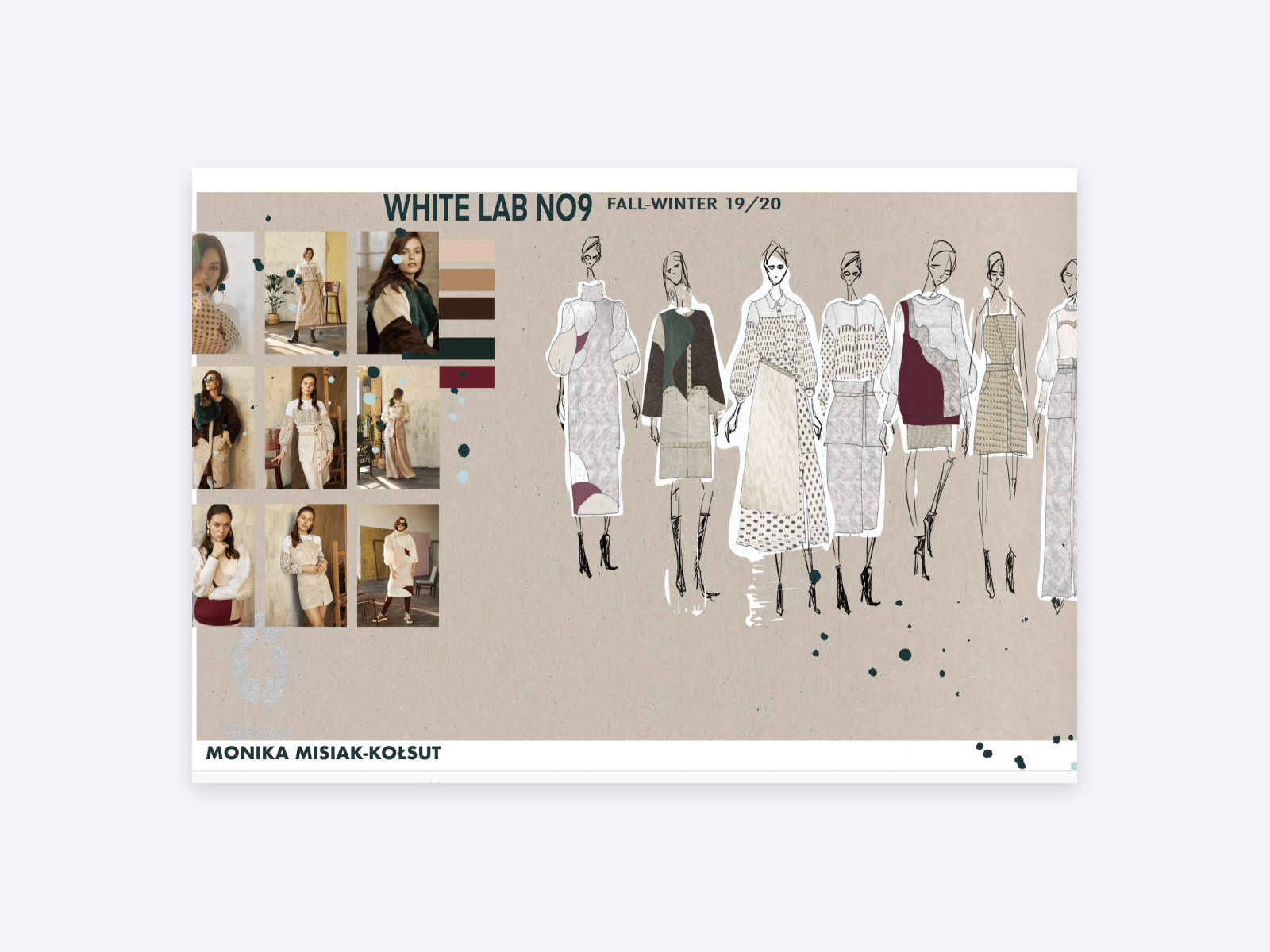
Monika's fashion portfolio
What can you learn from Monika’s fashion portfolio example?
- A detailed bio
Monika starts her portfolio with a precise bio, from which you can learn a bit more about her journey as a fashion designer and her accomplishments - Mood board with a context
Monika’s mood board includes a bit of background information on the colors and the silhouettes she's using in her collection. - Fashion sketches and photos
Next to her fashion sketches, you can find photos that match the mood of the drawings. She uses restrained colors, which radiate discreet femininity.
3. Tannistha Manna
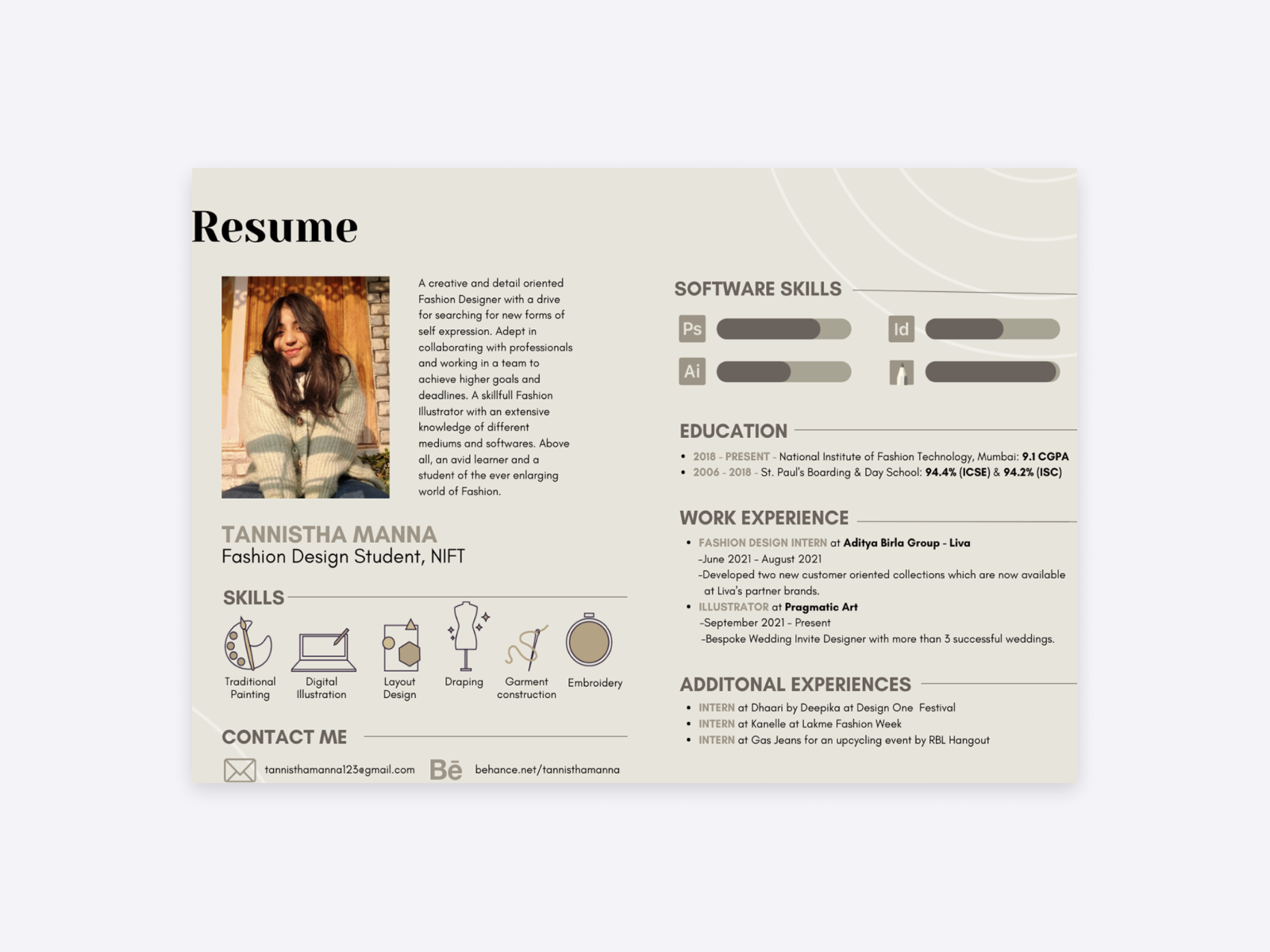
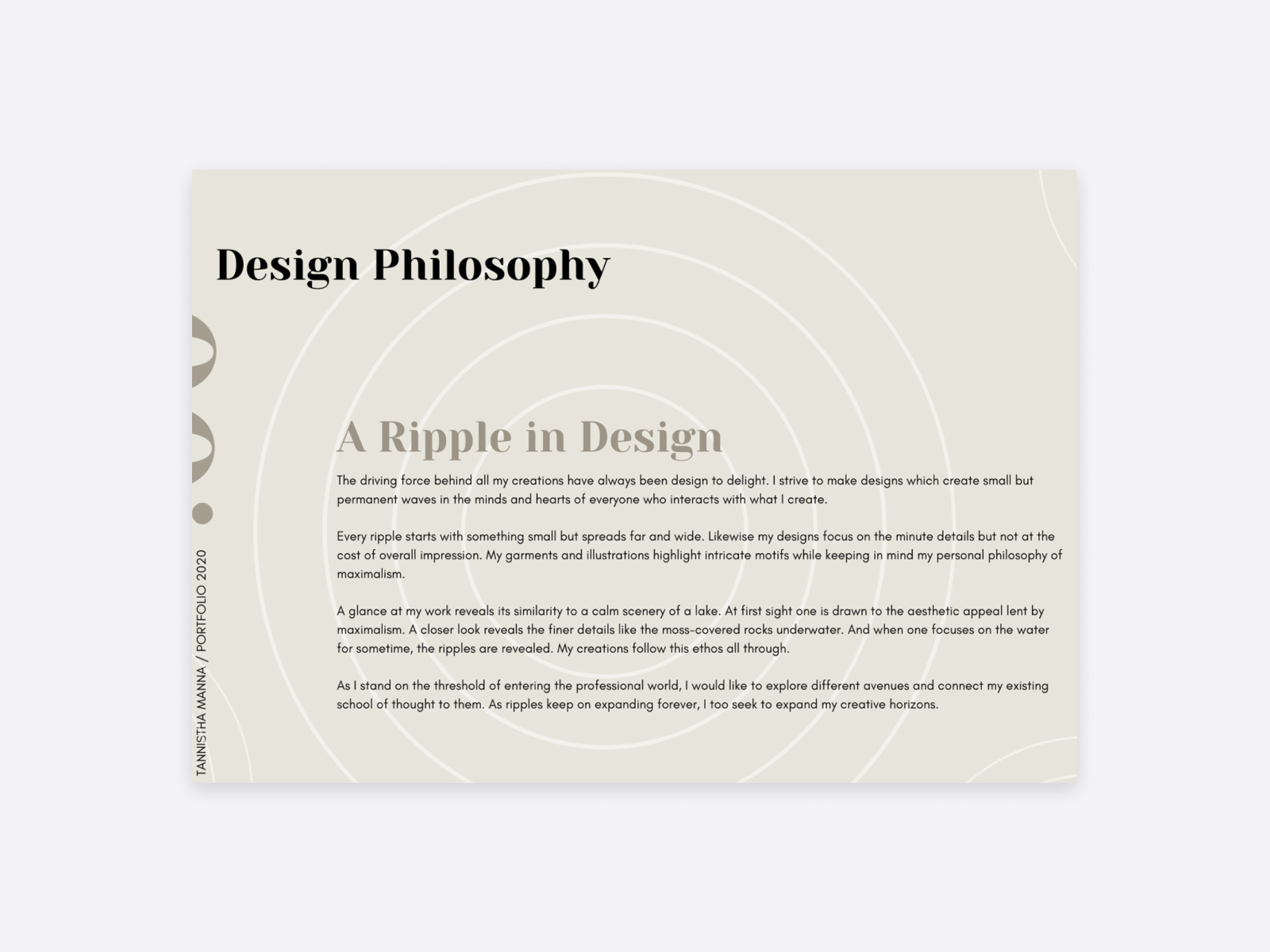
Tannishta's fashion portfolio
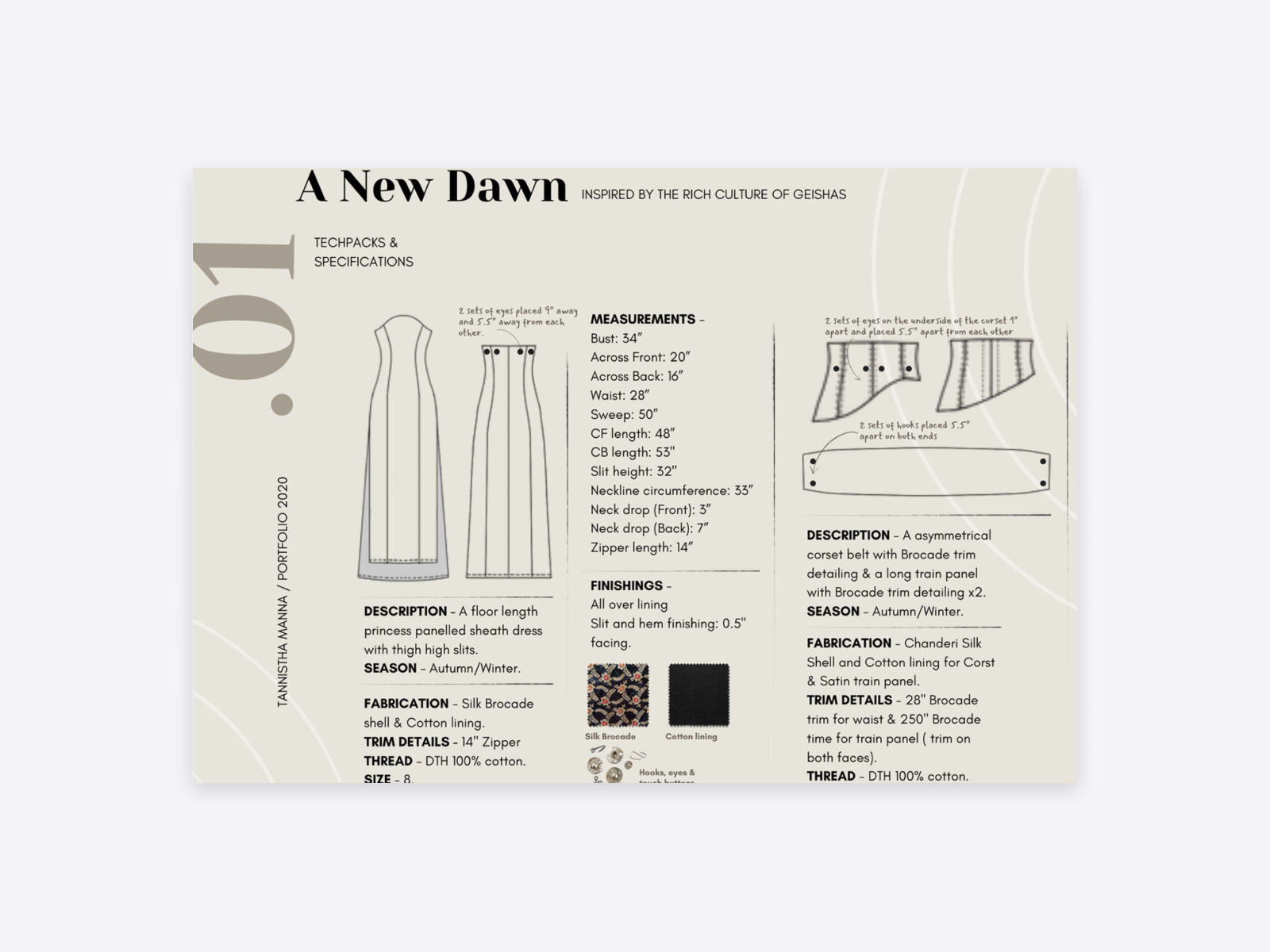
Tannistha's fashion portfolio
What can you learn from Tannishta’s fashion portfolio?
- An innovative resume
Tannistha’s resume is the perfect combination of copy and design. You can gather just the right information about her without being overwhelmed. You can find the contact information, her school and work experience, and her software skills. - Design philosophy
This is one of the key takeaways from her portfolio: by putting philosophy behind your designs the viewer is able to put them into context. - Techpacks and specifications
One of the greatest assets of Tannistha's portfolio is that she's not afraid to get into details with her designs. It's clear, transparent, and on point, so you can easily follow her design process.
4. Chris Pack

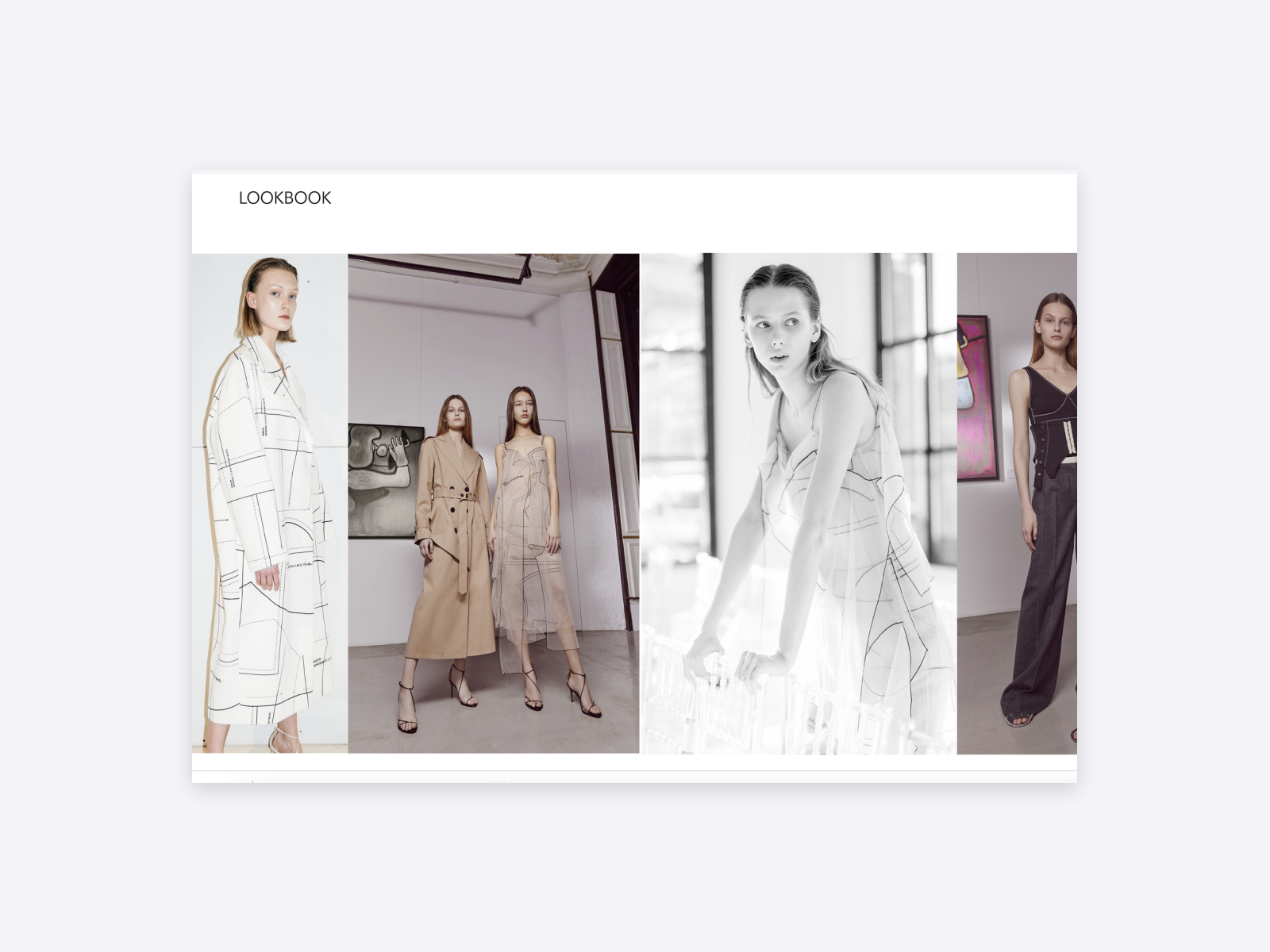
Chris Pack's fashion portfolio
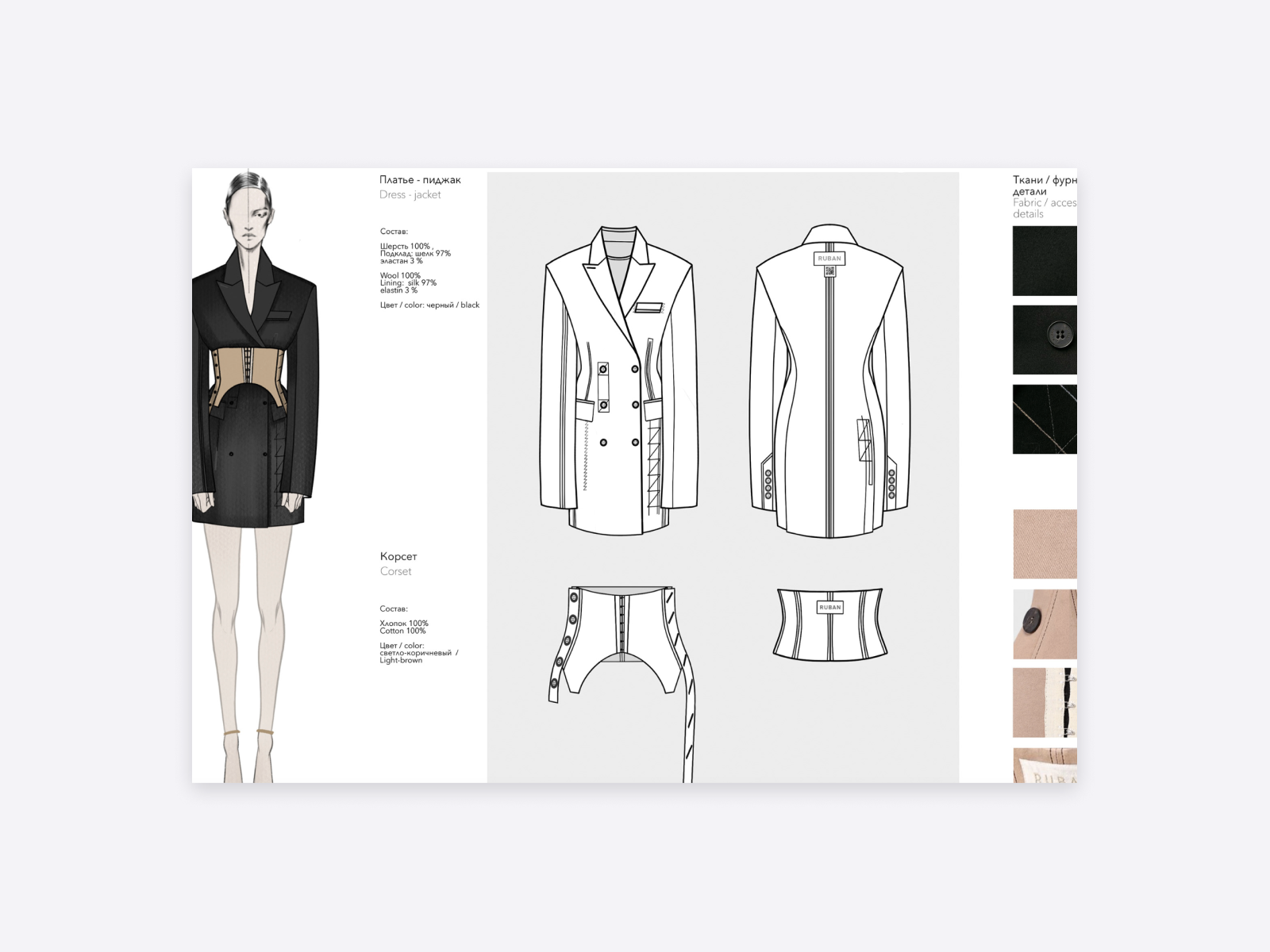
Chris Pack's fashion portfolio
What can you learn from Chris Pack’s portfolio?
- Inspiration/design development
Chris has detailed and illustrated a page on how and where he gathers inspiration. He includes architectural and interior design, next to fashion design collections. - Lookbook
A lookbook is a must when it comes to fashion portfolios. This is an ideal way to showcase your ready-to-wear designs on models, so your visitors can see the entire process of your design method and the latest results of it. - Fashion sketches
Another example of a clear and transparent fashion sketch. On the right-hand side, Chris included some snippets from the fabrics and the details, which make the design even more complete.
5. Simran Chopra
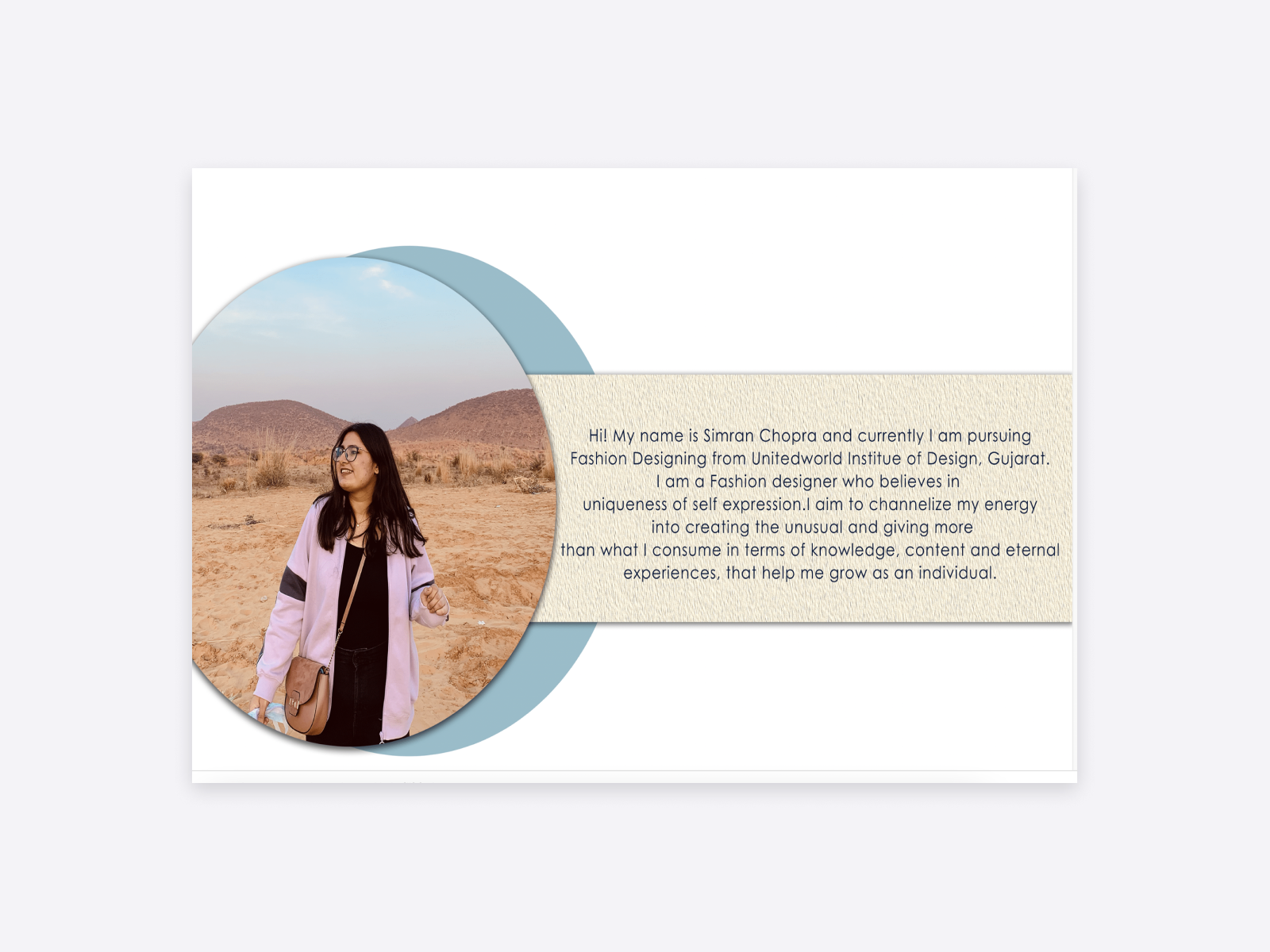
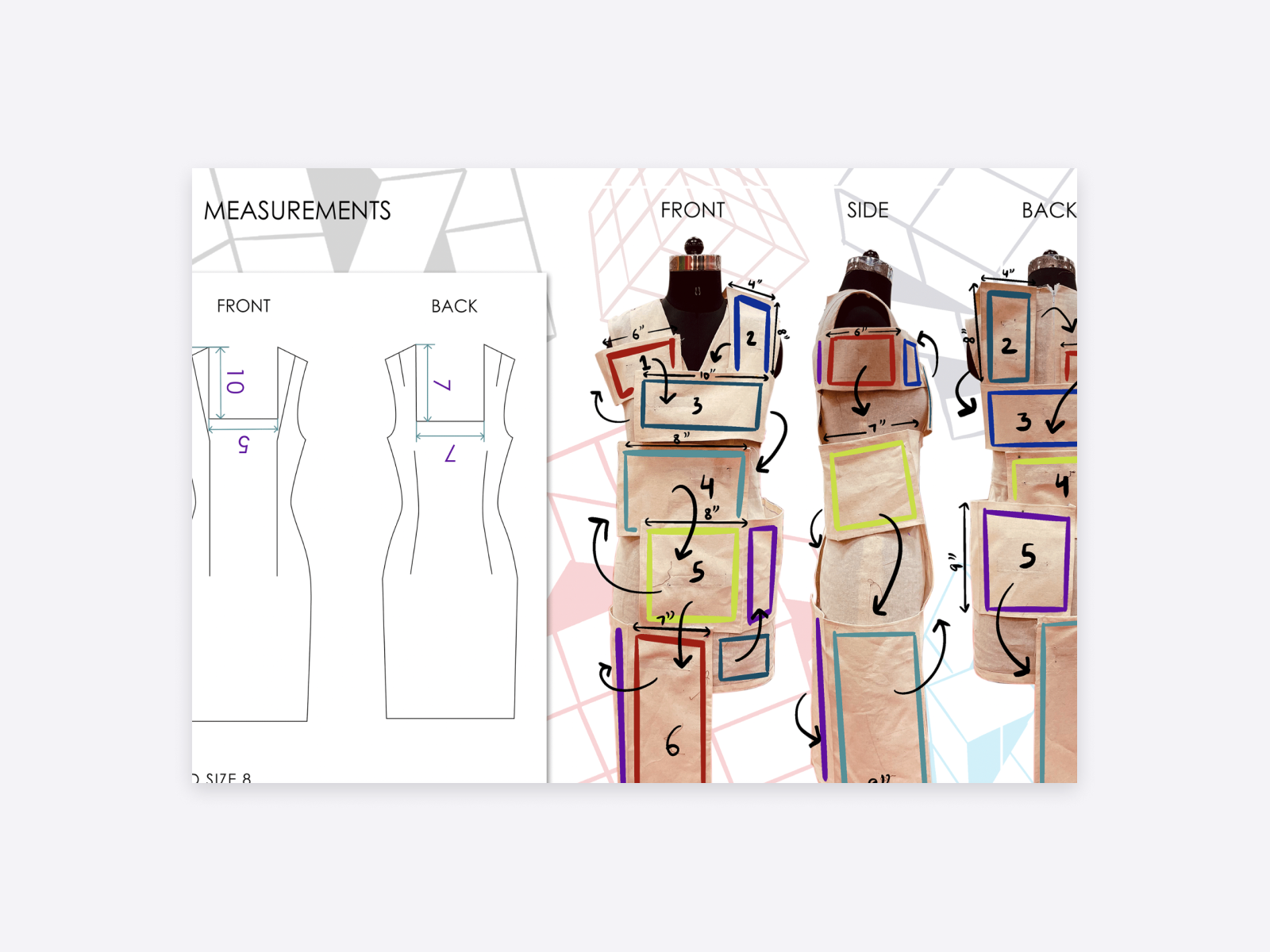
Simran's fashion portfolio

Simran's fashion portfolio
What can you learn from Simran Chopra’s fashion portfolio example?
- Short bio on the front page
Simran’s portfolio starts with a short bio, where she summarizes her goals and beliefs as a fashion designer. This is a perfect way to introduce yourself in a couple of sentences. Read more about how to create the perfect about me page. - Showing a detailed design project
Recruiters and hiring managers are interested in your thinking, more specifically in your design process. Make sure to showcase that in your fashion portfolio. - Motif ideation
Show the inspiration behind your design process and highlight elements and themes that connect your creations.
6. Aditi Singh
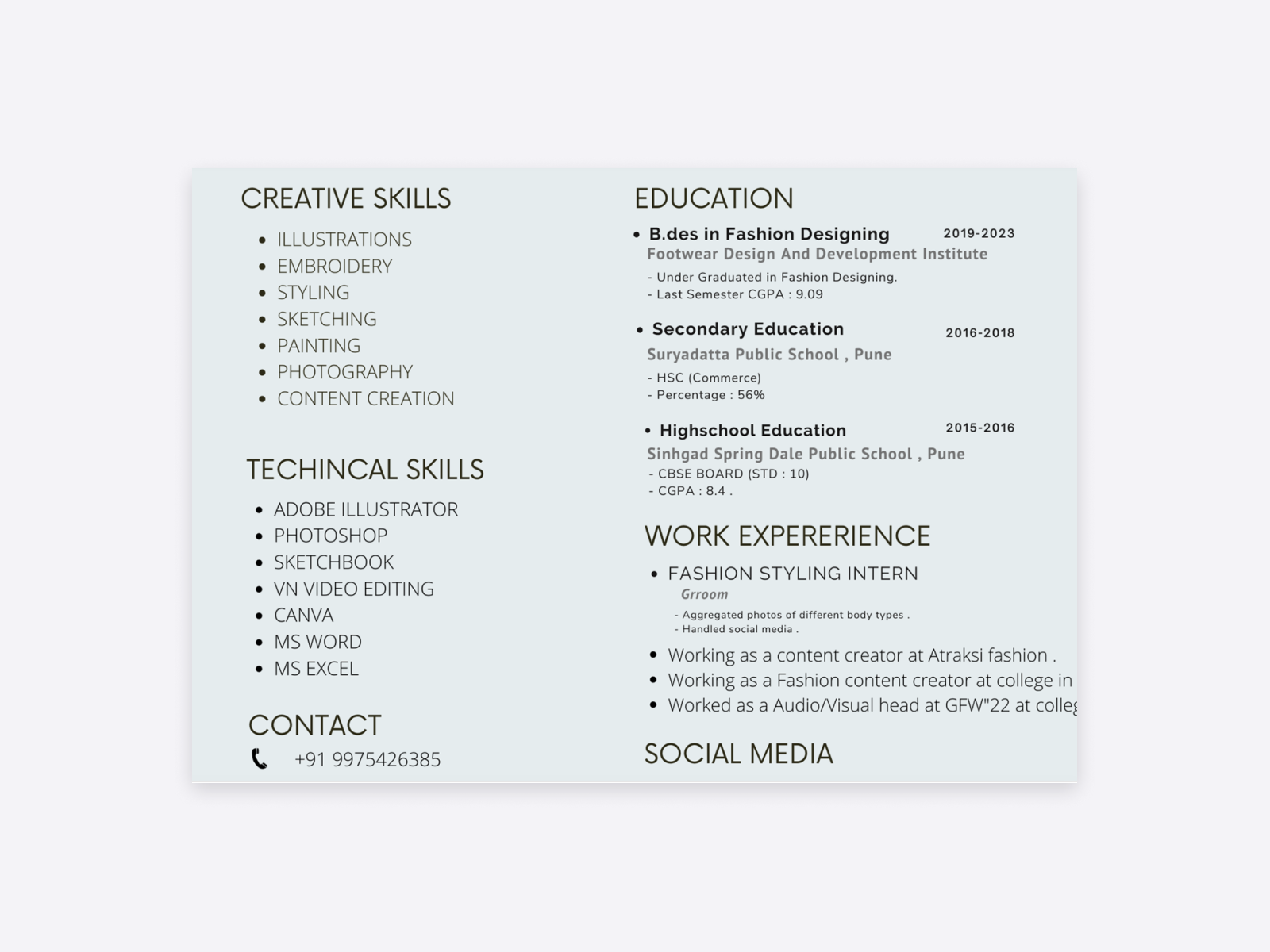

Aditi's fashion portfolio

Aditi's fashion portfolio
What can you learn from Aditi Singh’s fashion portfolio example?
- Detailed skills
Aditi is detailing not only her education and work experience but also her technical and creative skills. This is something that you can easily add to your portfolio. - Inspiration board
Inspiration boards are diverse: they vary from fashion designer to fashion designer. Aditi’s inspiration board includes fashion sketches and a set of plates, in blue and white colors. Don’t be afraid to experiment with your own personal inspiration board. - Magazine features
Highlight your accomplishments, and include magazine features or any other achievements in your portfolio.
7. Verrel Widura

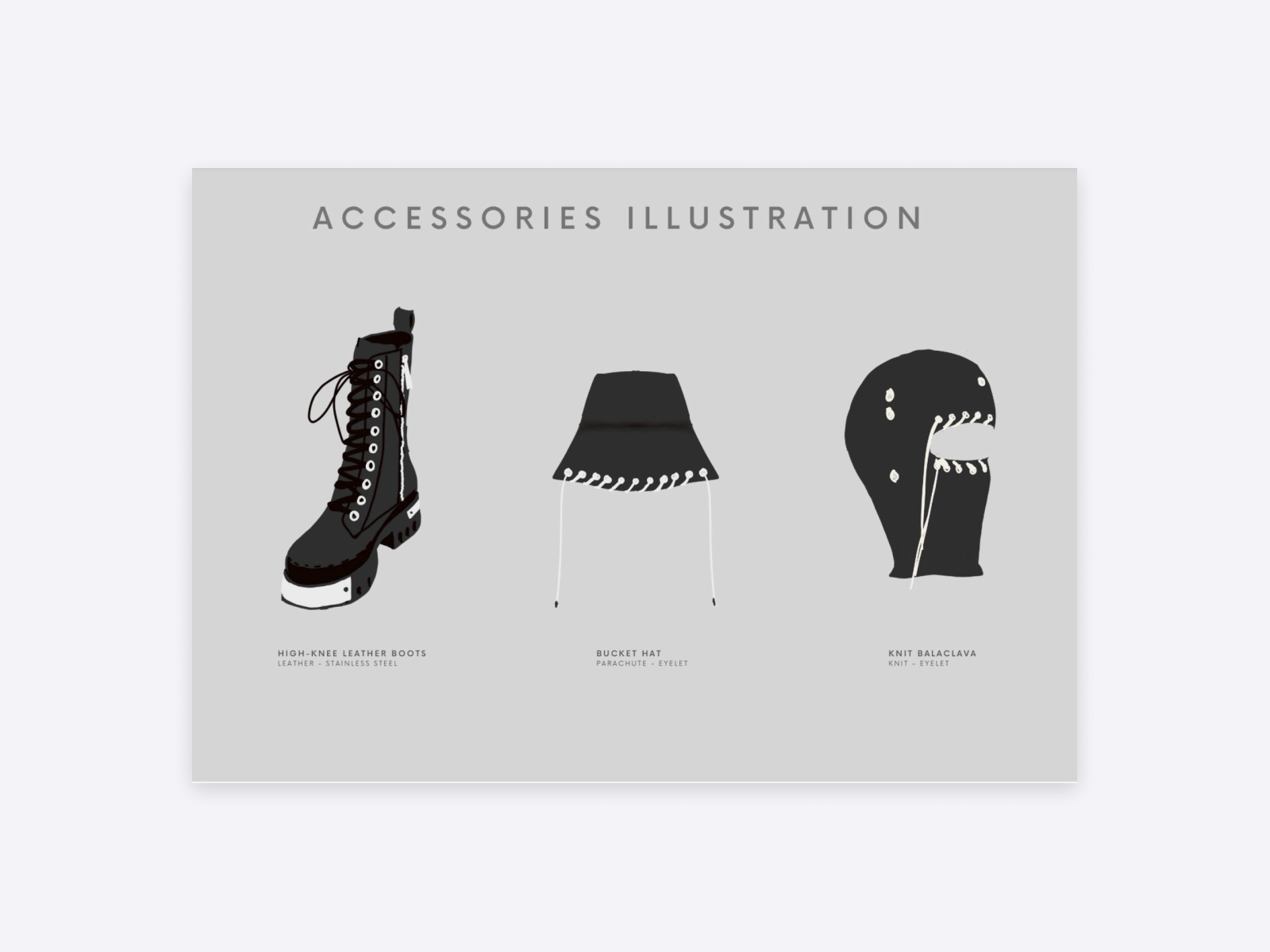
Verrel's fashion portfolio

Verrel's fashion portfolio
What can you learn from Verrel Widura’s fashion portfolio example?
- Target audience
Verrel is showing his collection and his research work that led to his final designs. You can see that he includes an accurate potential buyer audience, with geographic, demographic, and psychographic details. - Accessories illustration
A good example of including not only sketches of dresses but also of accessories. Verrel included fashion sketches from three different accessories: a hat, a boot, and a knit balaclava. - The design process with pictures
Verrel illustrates his entire design process with photos, so you can have more insights and background information on how he works.
8. Anisya Fresha Zalsabila

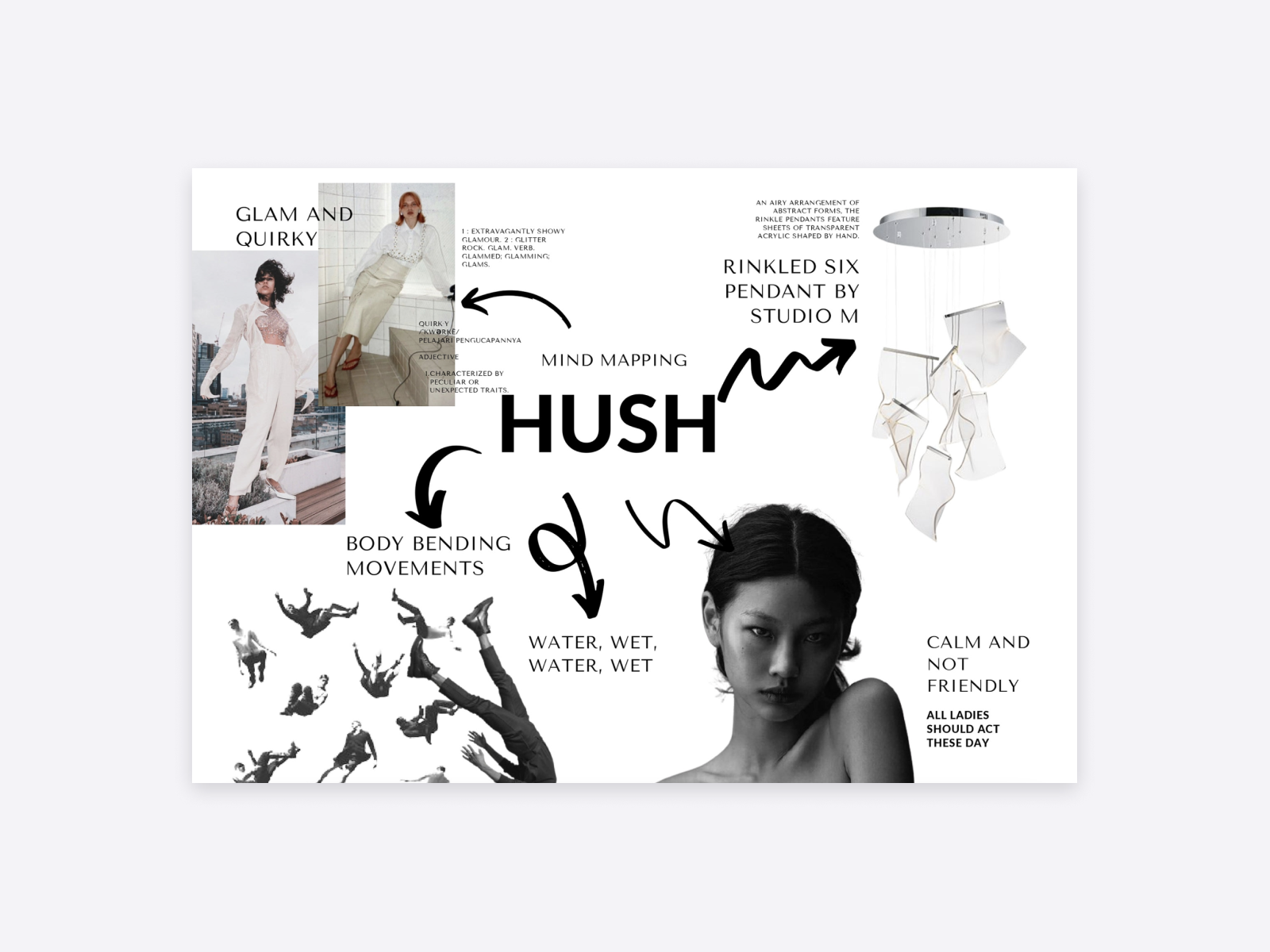
Anisya's fashion portfolio
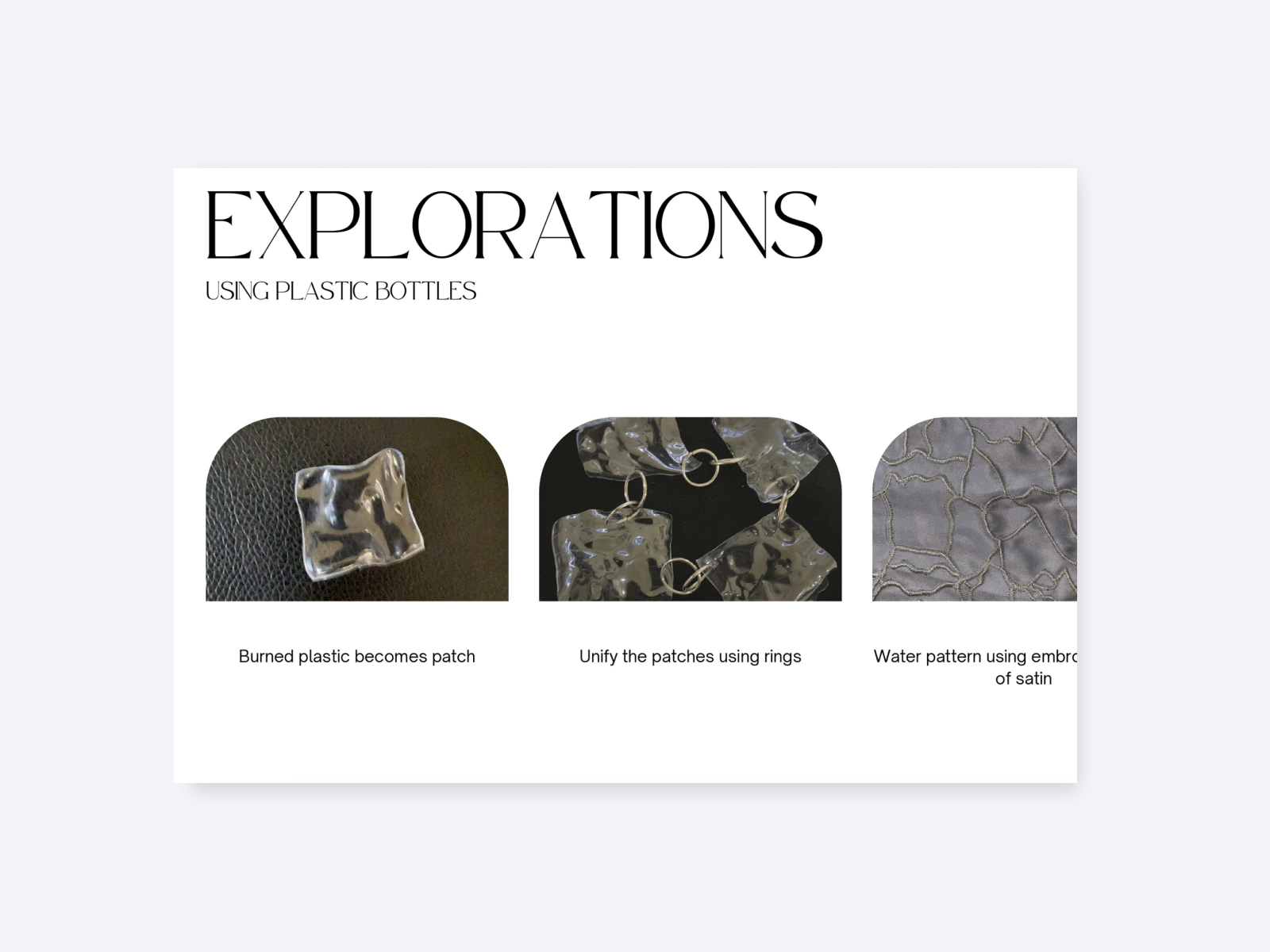
Anisya's fashion portfolio
What can you learn from Anisya’s portfolio?
- Mixing photos and illustrations
Anisya is mixing photos and illustrations in her sketching, which is not only unique but it's a great way to showcase your idea of the final product. - Mind mapping
Another great example of sharing your thoughts on future design is mind mapping. It's an intuitive and super easy way to plan different designs in the early stages of the design process. - Explorations
Don't be afraid to display your experiments and include discarded ideas. This shows not only your dedication to the project but also that you're not afraid to try different approaches.
9. Sushmitha S Gowda
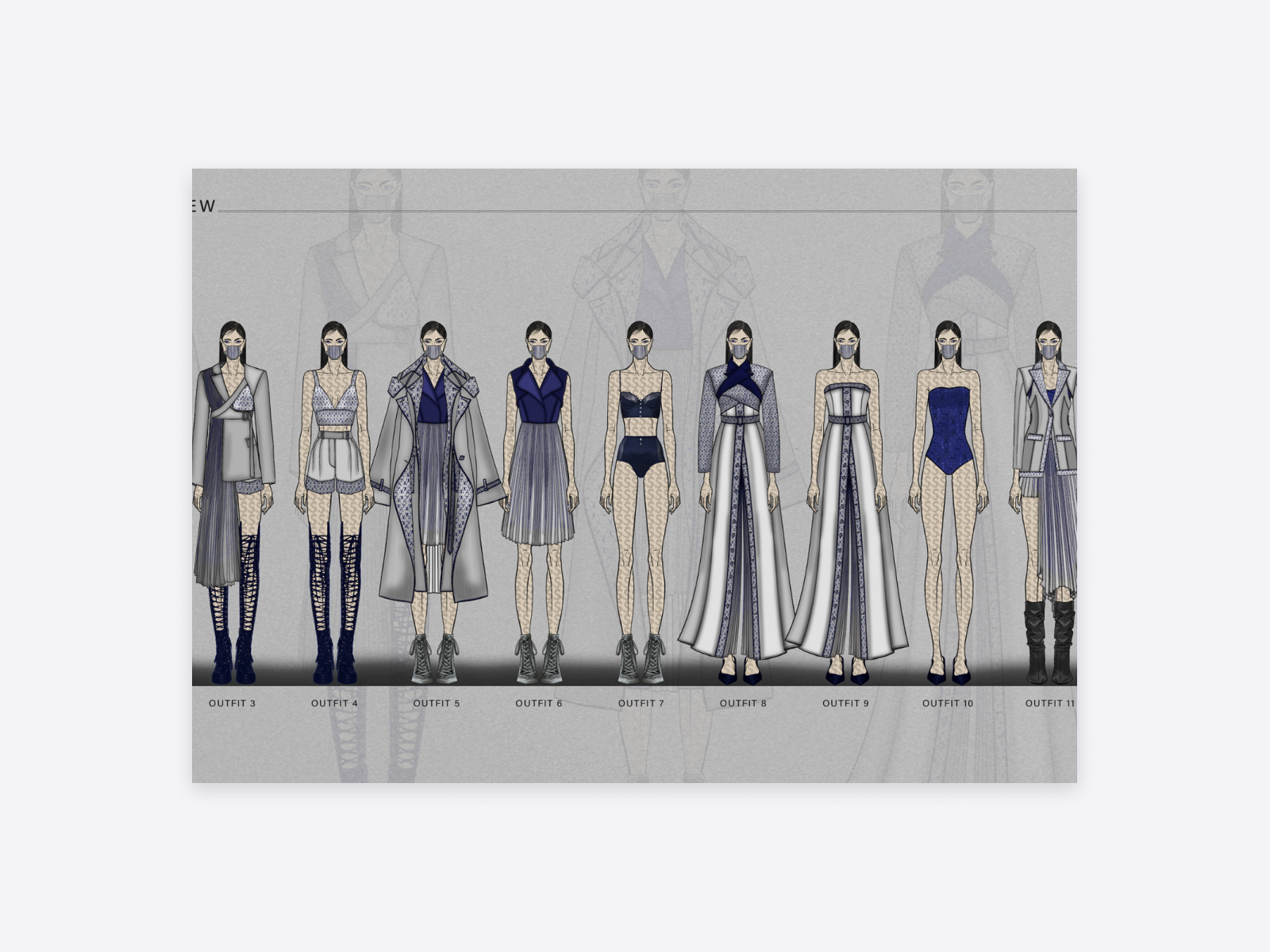

Sushmitha's fashion portfolio
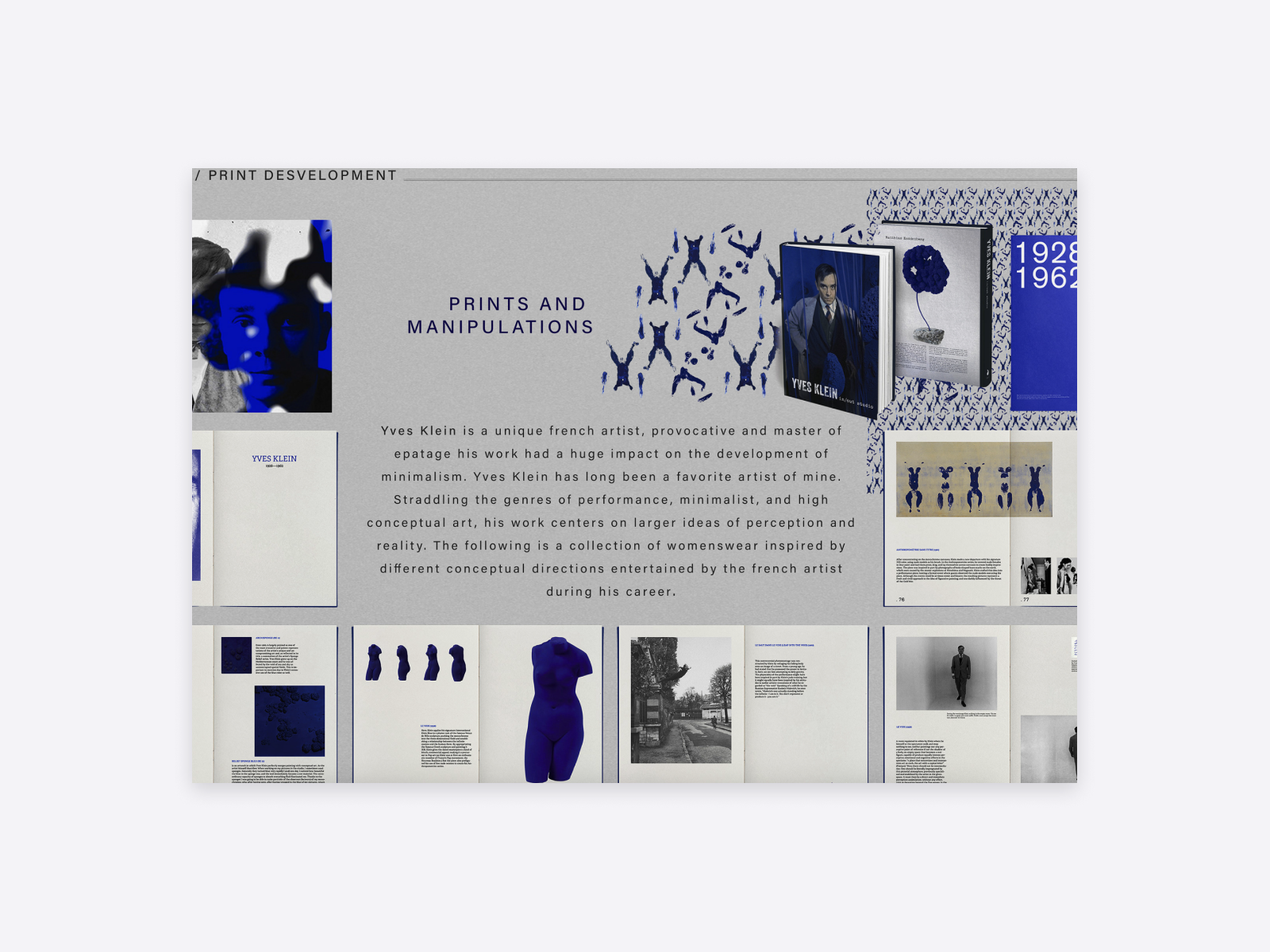
Sushmitha's fashion portfolio
What can you learn from Susmitha's fashion portfolio example?
- Show the sketches of the entire collection
Susmitha chose to show the entire collection in sketches. If you have a chance, it's best to display your collection in its full entirety, for the full effect. - Display your research process
Hiring managers and recruiters are interested in every minor detail. This also includes your research process, where you can put a concept behind your collection. - Introducing your muses
Susmitha's womenswear collection was inspired by the French artist Yves Klein. Showcase what inspires you, however abstract. It says a lot about your personality and artistic vision.
10. Sandeep Nagar
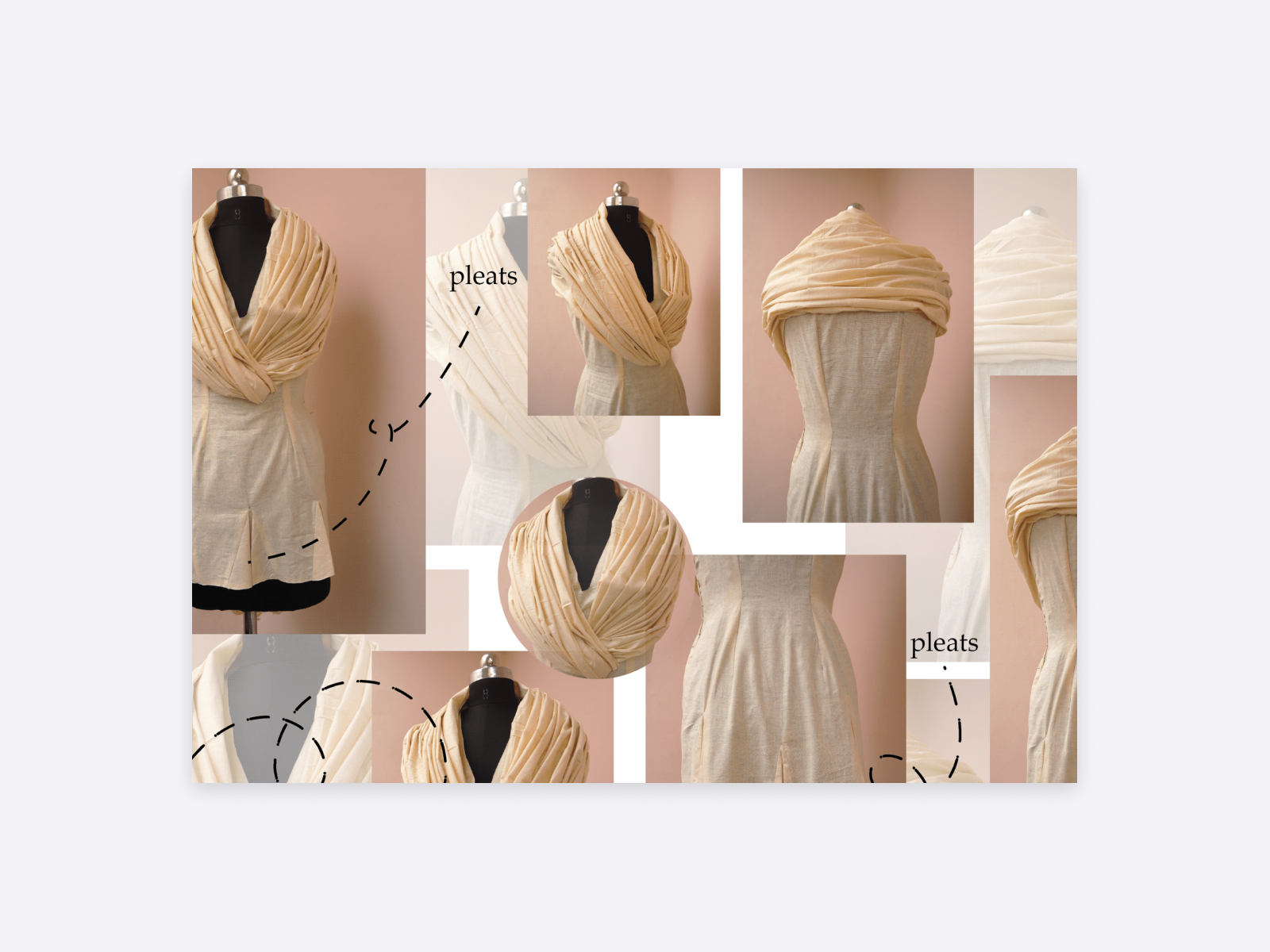
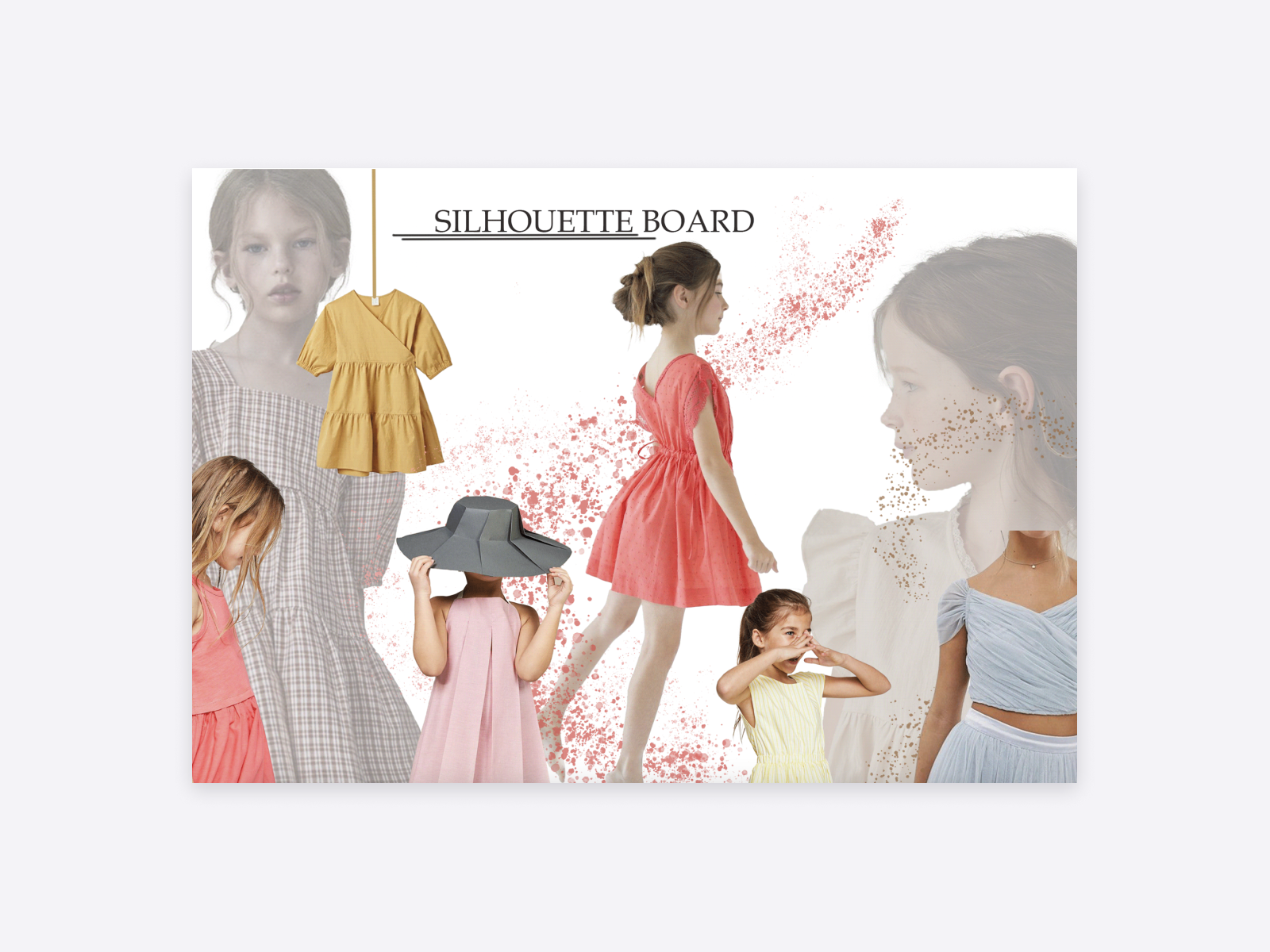
Sandeep's fashion portfolio
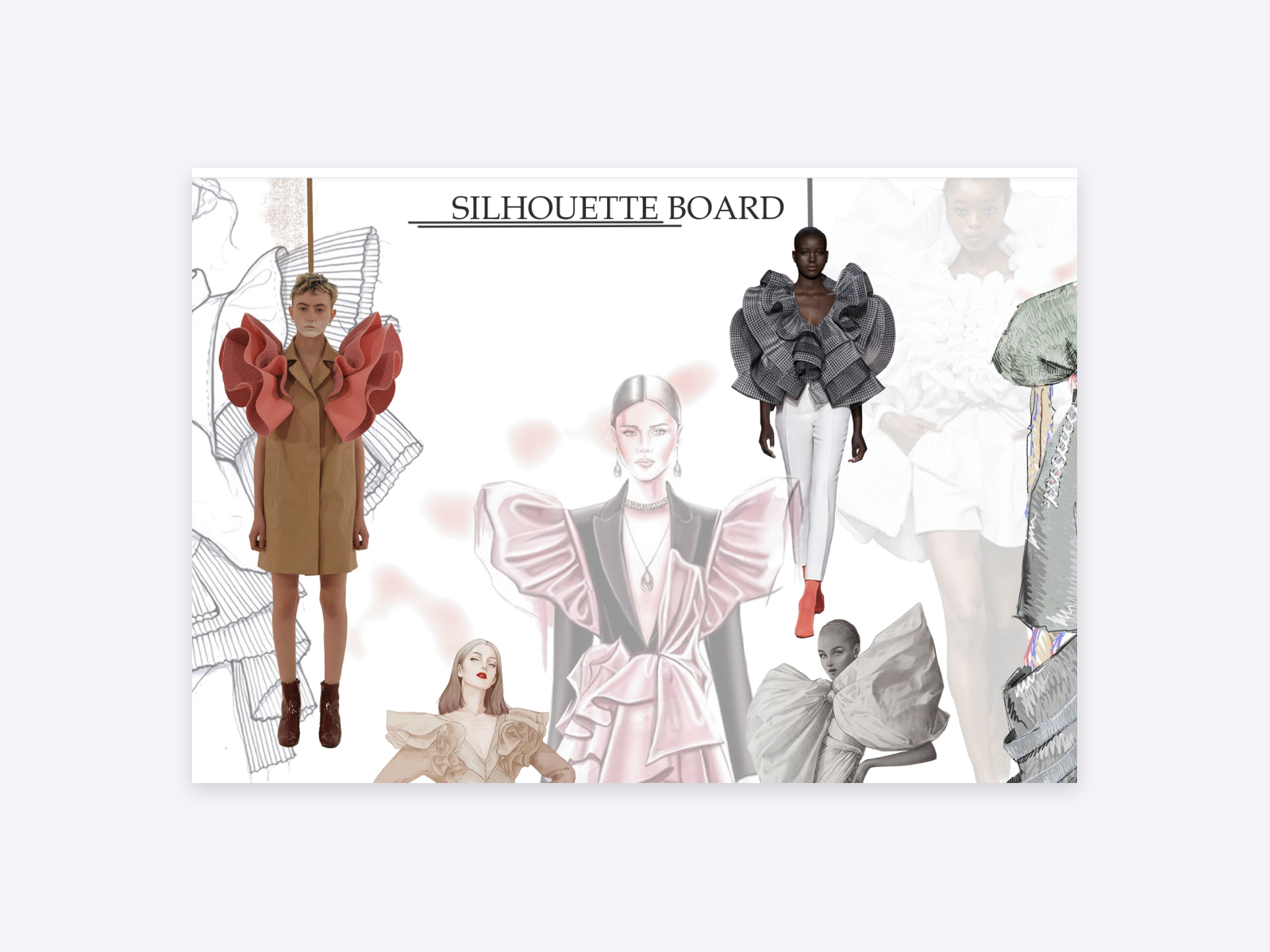
Sandeep's fashion portfolio
What can you learn from Sandeep’s fashion portfolio example?
- Photos and details
We’ve got a glimpse through Sandeep’s photos about his design process. He shows us how he is creating the actual dress, and processes are happening in the background. - Silhouette board
Whether you use photos or sketches, making a compilation that highlights your collection's silhouettes is a great way to showcase the cohesion and craftmanship of your creations. Group them according to similar shapes, texture, fabric, color or theme. - Silhouette board mixing with models and sketches
Sandeep’s other silhouette board is a mixture of sketches and models. If you want to represent your collection in all kinds of ways, this is the best option to do it.
11. Yeo Wen Quing

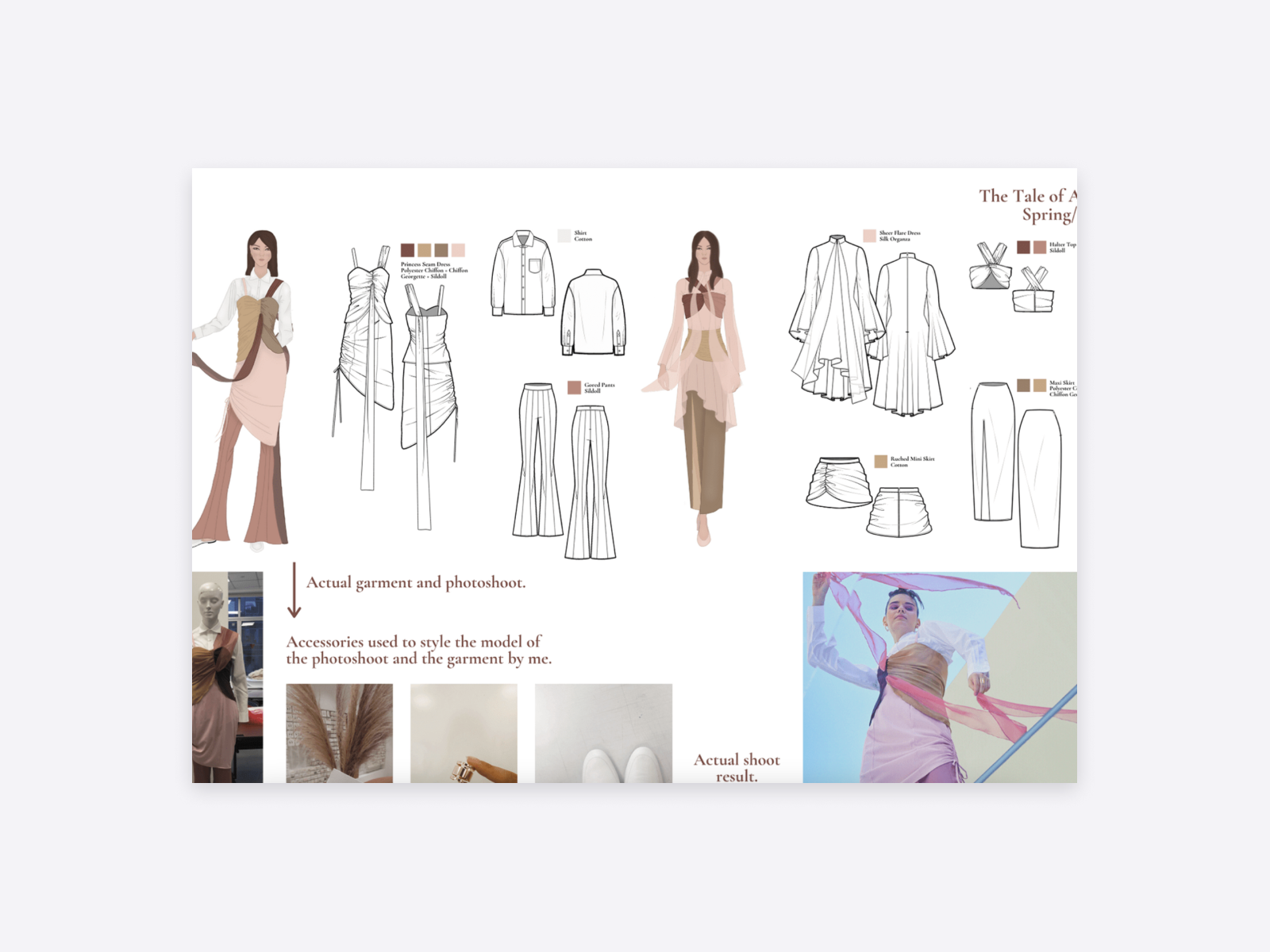
Yeo's fashion portfolio
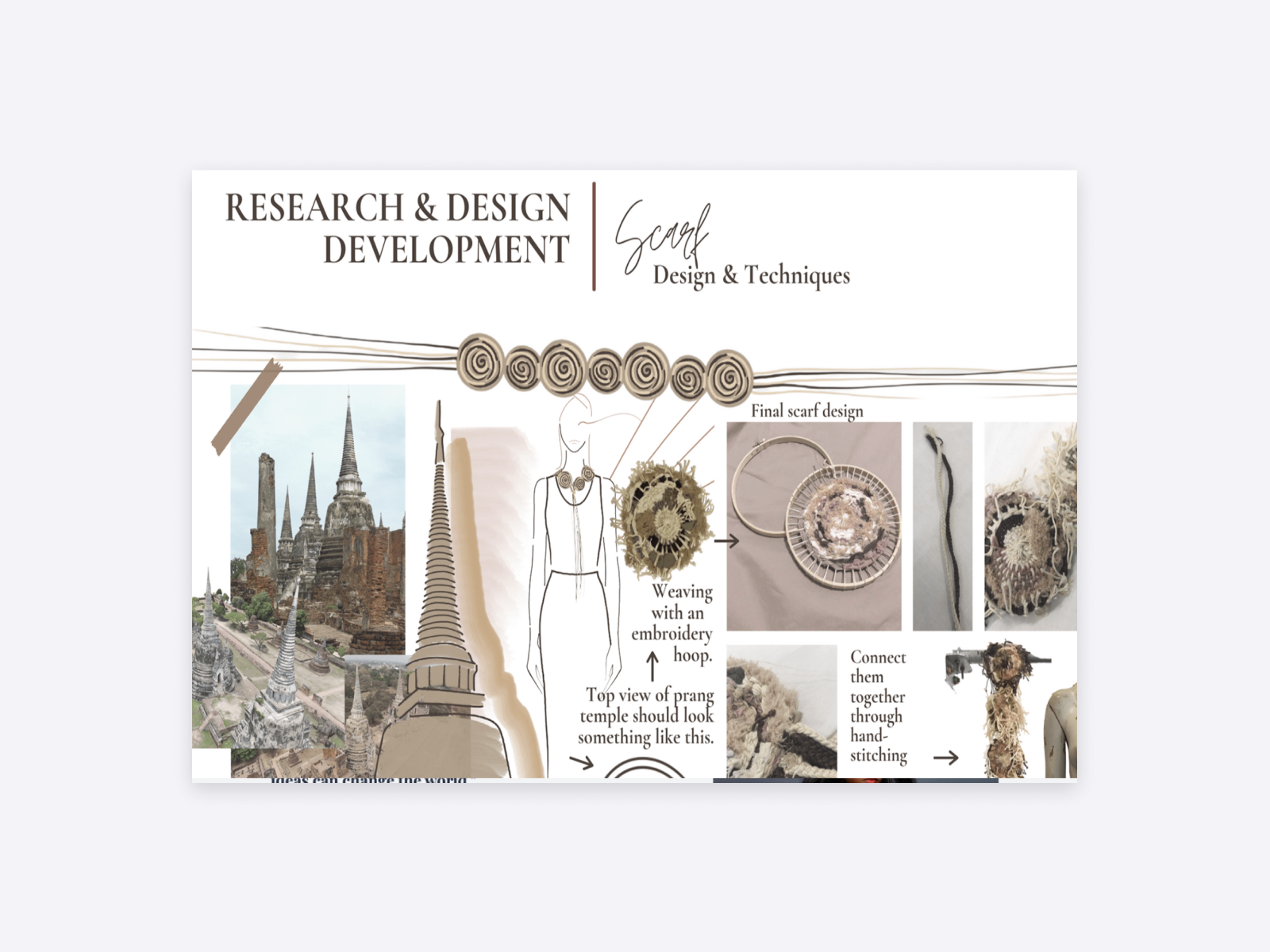
Yeo's fashion portfolio
What can you learn from Yeo’s fashion portfolio example?
- Styling proposal
It's always beneficial to show not only strictly your fashion design, but also other projects. This way hiring managers or recruiters are aware of your versatility and skills. - Accessories and sketches
Yeo is showing us her sketches and also the actual garment on the day of the photoshoot, on the same page. This before/after approach is very handy because you can see the ultimate results straight away. - Research and design development
It's worth showing the development not only for entire collections but also for accessories. It can say a lot about your approach.
12. Betsey Elias
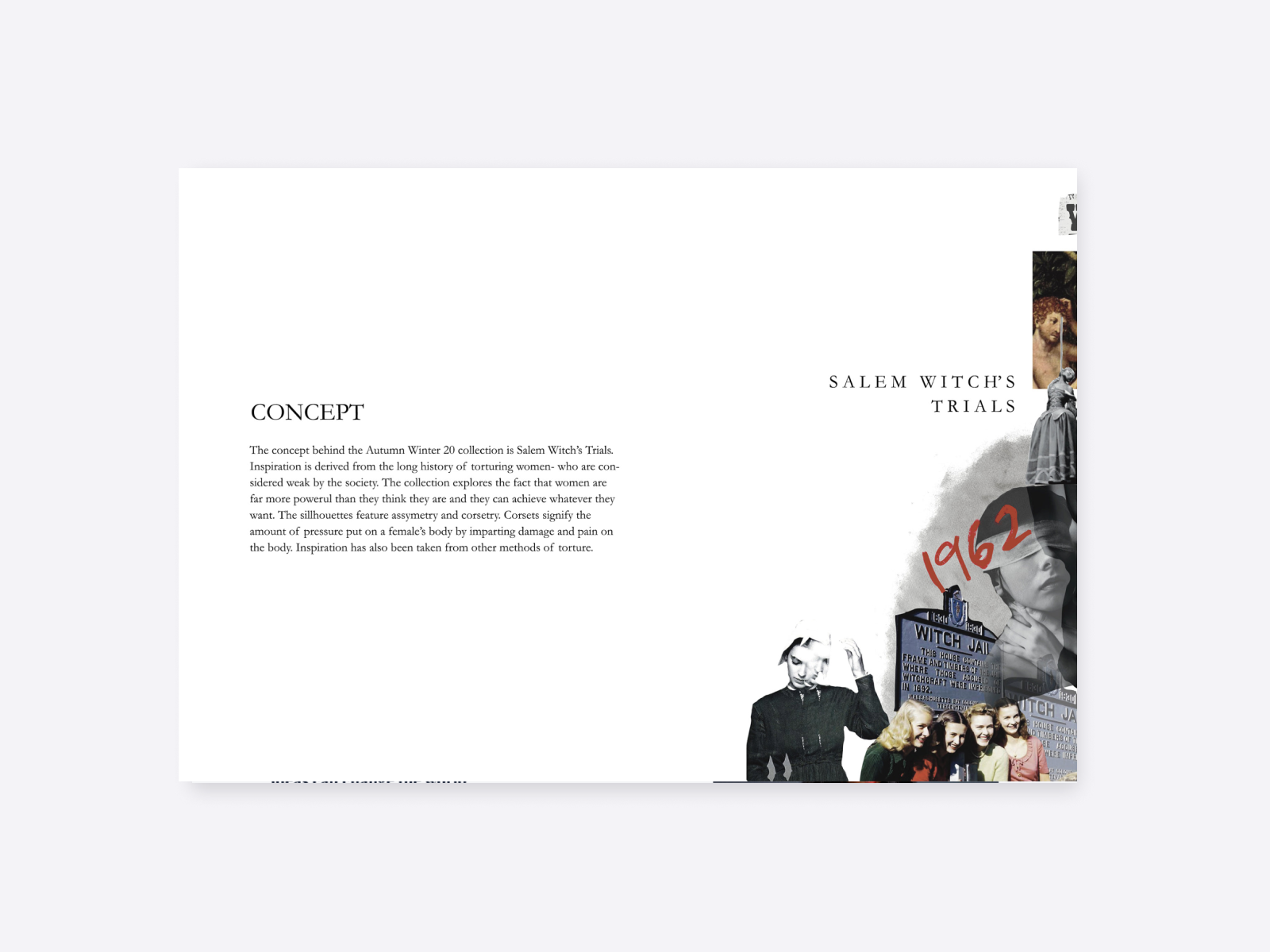

Betsey's fashion portfolio
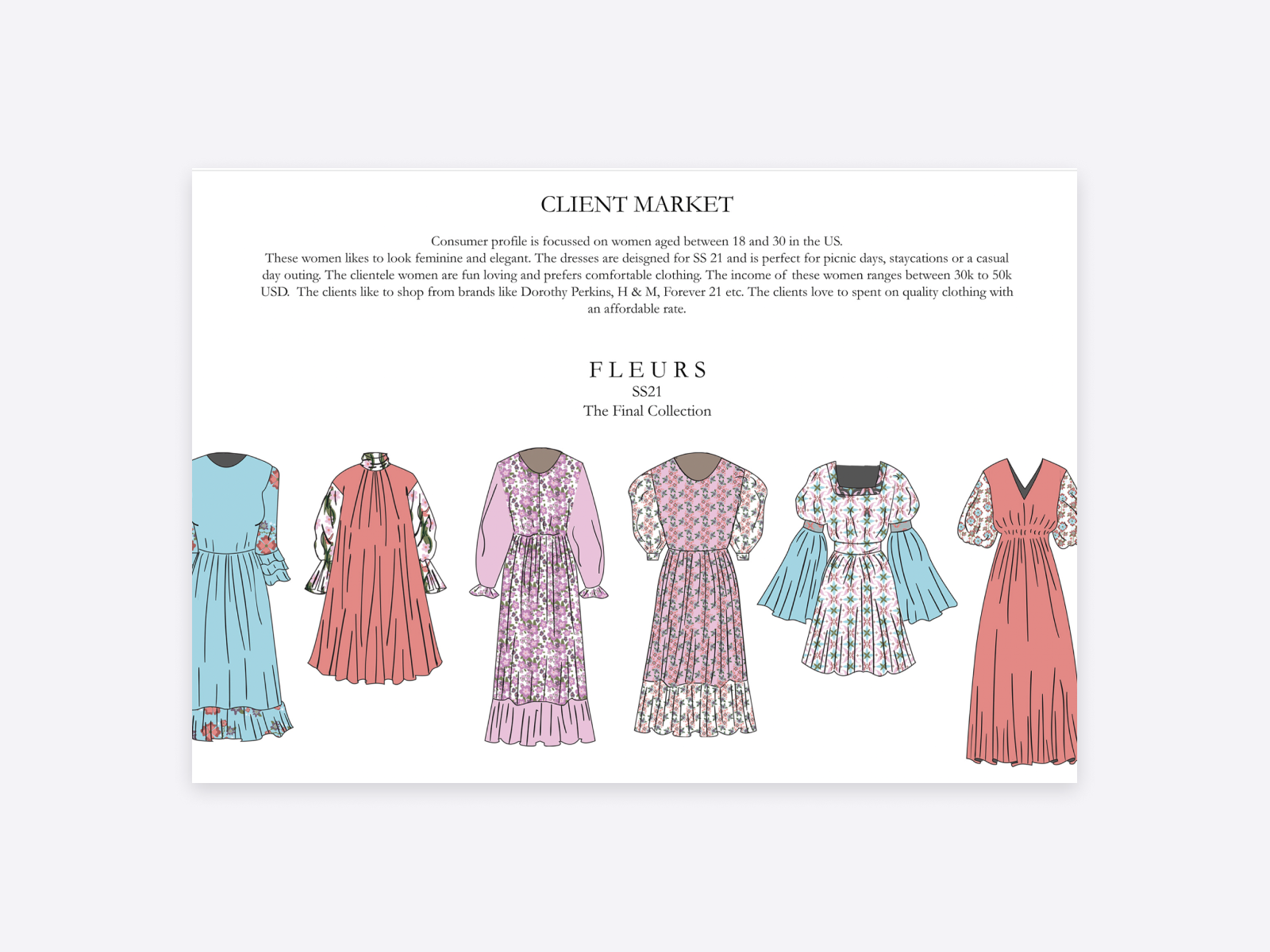
Betsey's fashion portfolio
What can you learn from Betsey’s portfolio?
- Concept
Betsey's portfolio is a graduation portfolio, which is why the concept of the design is different. She writes about it in detail, which can be quite useful because it highlights the context of your design. - Show your other side
Betsey does fashion illustration just for herself, but she isb'r afraid to show it to her audience. If you have work, which is related to fashion design, but not linked to your collection, you can still display it. - Client market
Betsey did some research on the client market for her collection. She included her fashion sketches next to it, therefore you can have a closer idea of what and to whom she wants to sell.
+1. Fransico Diegues
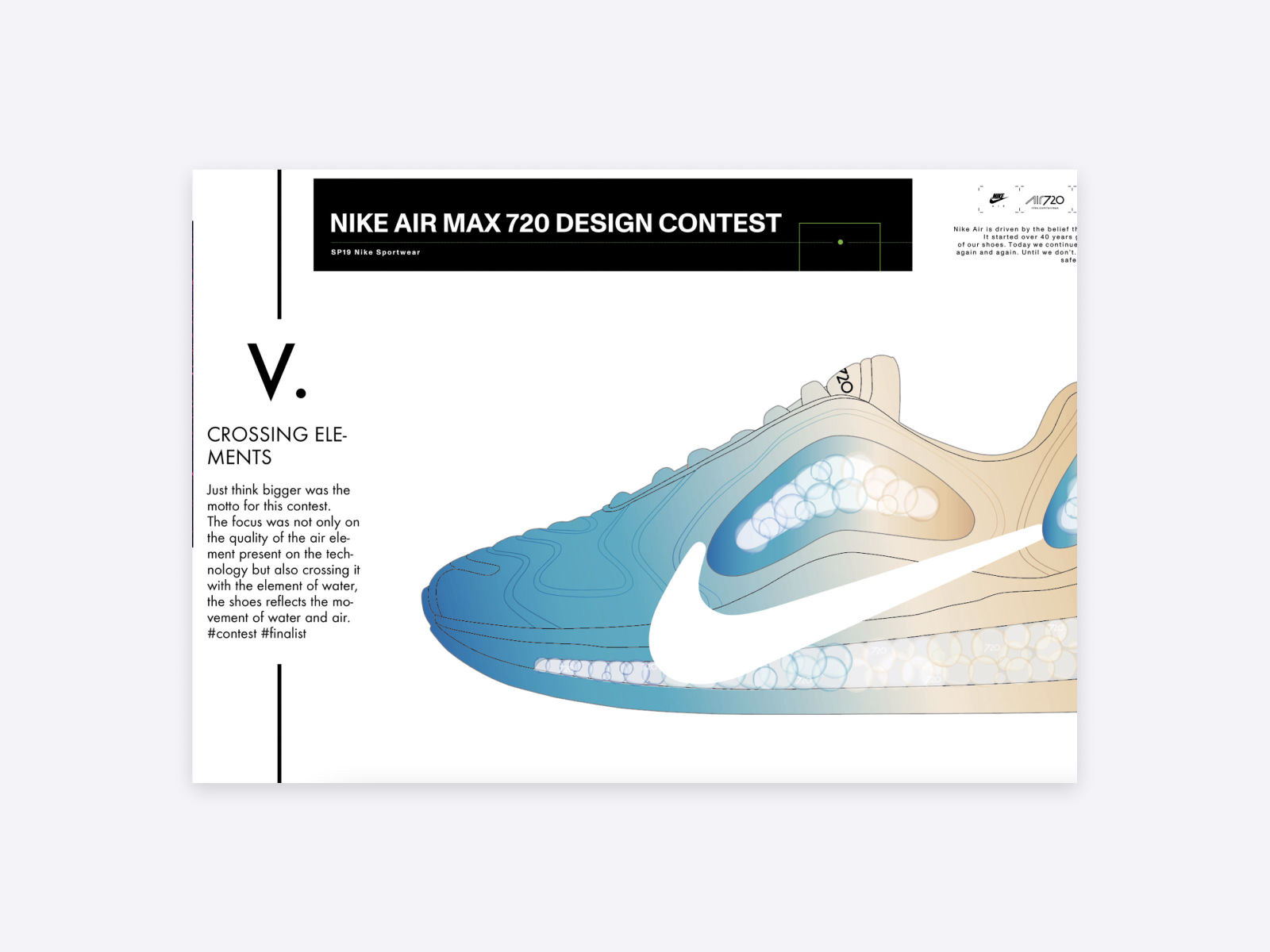
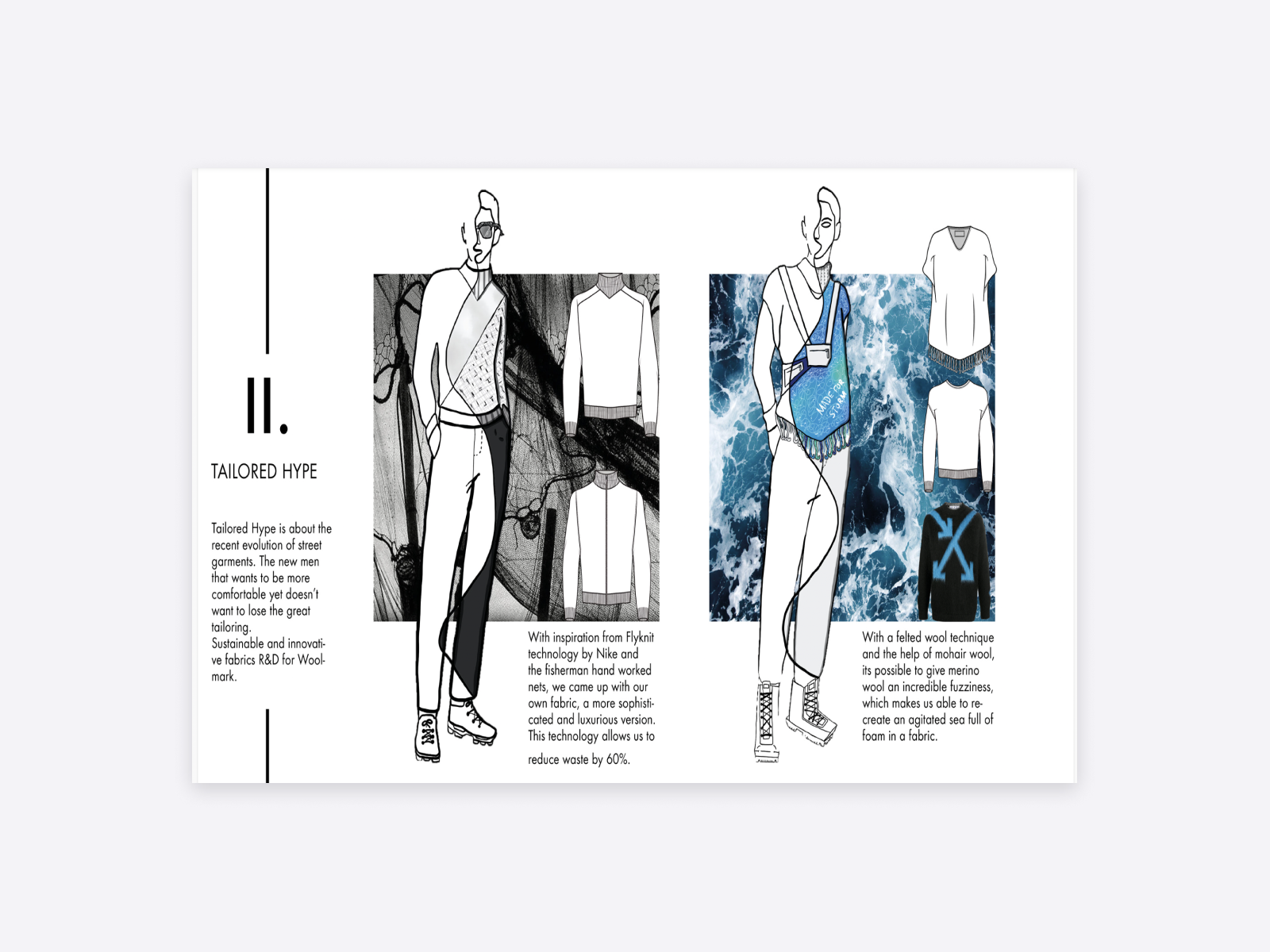
Fransico's fashion portfolio
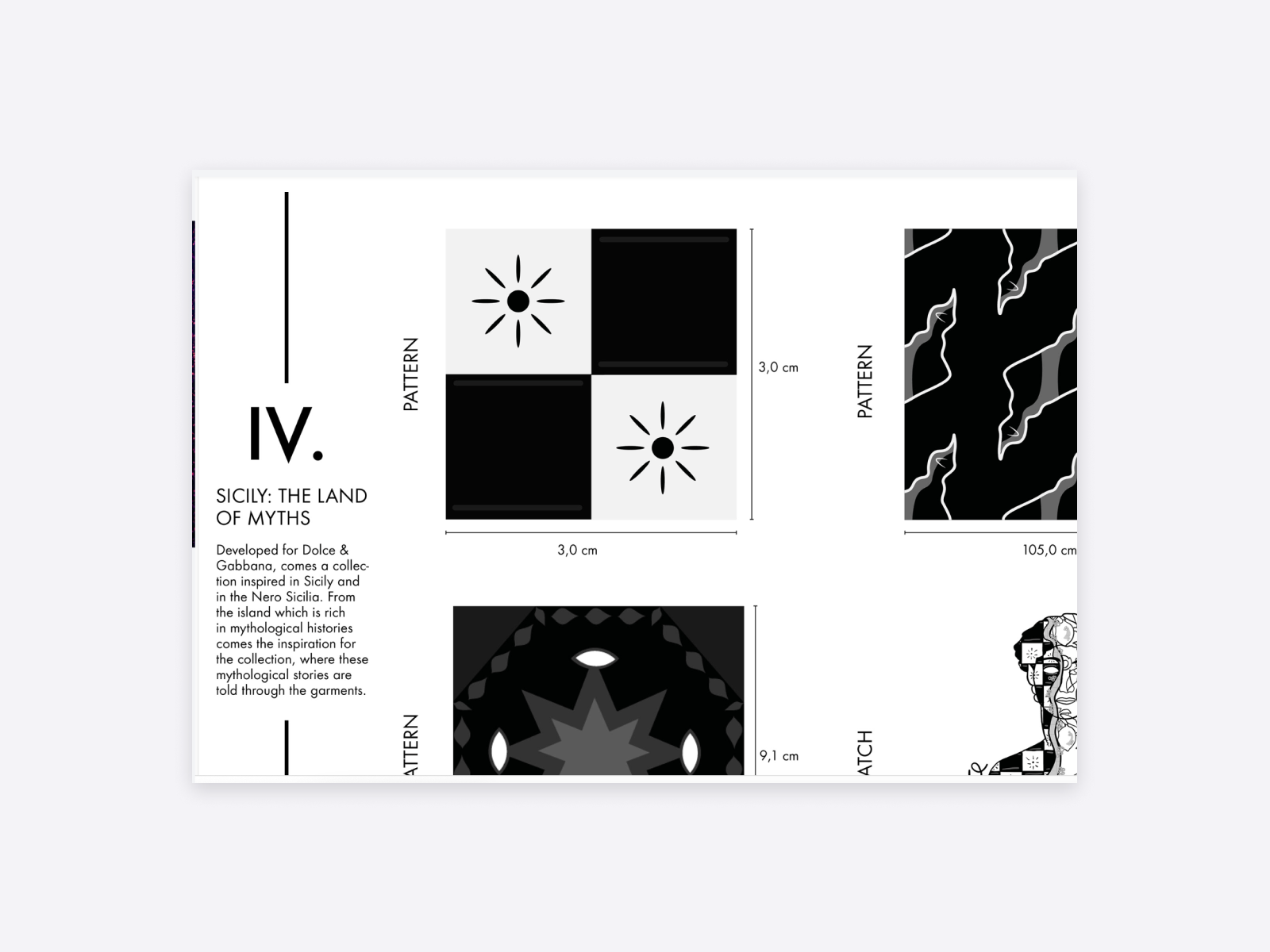
Fransico's fashion portfolio
What can you learn from Fransico’s portfolio?
- Design contest
Include your accomplishments and your design contest work. They show that you are up for the challenges and you like to test yourself: you can kill two birds with one stone. - Fashion sketches in different colors
Fransico included some concepts next to his unique designs which are black and white, and black and blue. You can see that he also highlighted that his design is not only unique but also eco-friendly. - Pattern tests
Fransisco gathered inspiration from Sicily, and from its mythological history. There are several pattern tests included, some of which made it to the final design.
4 + 1 key takeaways from these fashion portfolio examples
Now, as we browsed through some stunning fashion design portfolio examples, it's time to gather what you can learn from them, so you can get the ball rolling!
A short bio is a must
As you might have noticed, most of the portfolios included a short—or a more detailed—bio section. This is a place where you get to introduce yourself in a few sentences. Describe your journey as a designer, and also your technical and creative skills.
2. Show your design process
We have presented you with several approaches to showing your design process. Some of the designers used pictures, others chose to write about it. It's up to you which method you pick when it comes to your own portfolio.
3. Include inspiration boards and fashion sketches
For a fashion portfolio, inspiration/mood boards and fashion sketches are essential. How you display them is entirely up to you, and the mood of your design. Pitch black background, with white lines, or something more sophisticated? You decide.
4. Don't forget your accomplishments
Tv appearances, mentions from blog articles, or influencer collaborations? Include all recognitions, whether it's big or small, into your portfolio—because you are proud of them, right?
+1. Assemble and curate your work
It often happens that we have our work in several places. Gather them, so it is much more transparent and easier to work with. As you don't want to build an extensive fashion design portfolio, choosing your 3 - 5 best designs/projects is best. Make sure these show the scope and versitality of your skills.

Fashion portfolio tools
There are plenty of ways for designers to create their own fashion design portfolio. We collected 3 options to choose from.
We ourselves are currently working on a portfolio builder tool dedicated to fashion designers. Want to have early bird access? Subscribe to our newsletter and get the latest news straight to your inbox.
General portfolio builders
If you are committed to creating a portfolio, general portfolio builders can be a good option. Behance, Adobe Portfolio, or Format are decent solutions for general purposes. Although they have minor flaws, they are a good fit for those who don’t have any specific needs or expectations. Keep in mind that portfolio builders are not websites, they only show a series of work or a particular project.
A website contains a lot more information about the designer, each section with a different purpose. With general portfolio builders, you don’t have this option, it only focuses on a group of work. Different portfolio builders offer different levels of customization. Most of them use a pre-made template, where you can drag and drop your own content, but there is not much space for creative self-realization.
Website builders
You are probably familiar with general website builders, as they are often used for portfolio building. There are benefits to owning a website, but until then, the road can be pretty bumpy.
We only suggest using them if you have plenty of free time. As an example, you can choose WordPress, which is the most popular CMS in the world, but it can come with a steep learning curve.
Although WordPress offers a great deal of customization, this comes with a tremendous amount of plugins you have to download. This extends the date of the launch and also the setup itself.
Website builders such as Wix and Squarespace use built-in templates, which is a step easier than using WordPress, but still has its disadvantages. Wix templates are not interchangeable, so you can’t transfer content from one to another.
You can often face hidden fees you don’t expect first, and the plugins you need for a full-functioning website are pricey. Wix is a solid choice for someone, who only wants a general website, but probably not for those who wish for something more specific.
How to create your fashion portfolio website?
As you have seen several fashion portfolio examples above, you probably can't wait to start your own. Before you jump in, let us help you with some essential details. You will read about portfolio website builders, and how they can help you to reach your goal. You can also find out which is an ideal portfolio layout and structure.
How can a portfolio website builder help you?
How about having an outstanding portfolio website that's tailored to your needs right away? Sounds excellent, right? Let the facts speak for themselves. Here is how our tool can help you create your fashion portfolio.
- Forget HTML and CSS. Leave the coding to us. You don't need to become a programmer, a graphic designer, and a copywriter for the sake of building a website. We are here to help you out.
- Use built-in templates. Our portfolio website builder has an extensive collection of built-in templates to choose from. This makes website building quicker and you can also personalize your templates.
- Write with ease. Have a hard time finding the right words? While you're building your site, there are some guiding questions helping you out in our editor, so you can be even more confident with your copy.
- Build your online brand. As someone working in such a competitive industry as fashion design, it is essential to be present in the digital world. Put your best feet forward, shine the light on your work, and use your portfolio website for building an online brand.
Fashion portfolio layout and structure
The 4 fundamental elements of a fashion designer portfolio are the following:
- Home page
- Contact page
- Link to your resume or a short bio
- Projects on your home page
These 4 elements are essential, but it is up to you how you tailor your portfolio website. As you are creating your website, think about your target audience and the goals you want to reach with the actual portfolio.
- What is your ultimate goal with your portfolio?
- Who is your target audience?
- How much time do they have to read your portfolio?
- How to showcase your work in the best way?
It might be worth pondering these questions while you are working on your website. If it helps, visualize it: write it down, or draw a picture of your perfect website.
Design your portfolio website in 4 steps
There is nothing left but to create your very own website, in only 4 steps. Let's get down to it!
- Choose a template that fits your style. You can browse through various templates, and you can change it anytime you like.
- Write the tagline and choose your main photo. Use a high-quality, and recent photo and write a couple of matter-of-fat sentences about yourself: who are you, what do you do, when did you learn to do it, why are you doing it?
- Add projects. Add projects on your home page you are truly proud of and write a couple of sentences about them. Consider the process behind them, the inspiration and the context.
- Fill in the contact page. Make it easy to get in touch with you. After all, this is the goal, right?
Share your fashion portfolio
Congratulations, you did the hardest part! There is only one thing left: to share your fashion portfolio with the world.
- LinkedIn. LinkedIn is the world's largest platform for professionals. Hiring managers and recruiters use it on a daily basis, therefore sharing your portfolio in a post and also in your profile can largely benefit you.
- Social Media. Do you have a dedicated platform for your professional work? Place your portfolio link in the bio, so your visitors can reach it, with only one click.
- Email. Place the link to your portfolio in your signature, so every email you send out automatically draws attention to it.

The key takeaways
- Assemble your work, and curate your best designs: quality over quantity should be your approach
- Choose your portfolio tool wisely, and find out what helps you to reach your goals
- A portfolio website has 4 key elements: home page, project page, contact details, and a short bio or link to your resume
- Always think about your goals and your target audience, and ask questions before you start to build your portfolio website
- Once you have done it, do not forget to share it!
